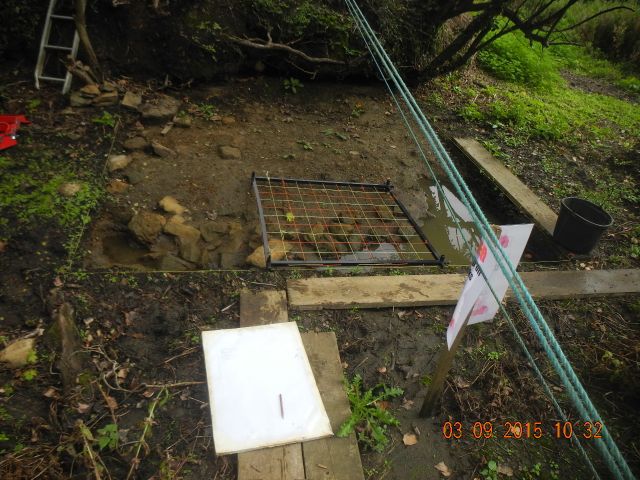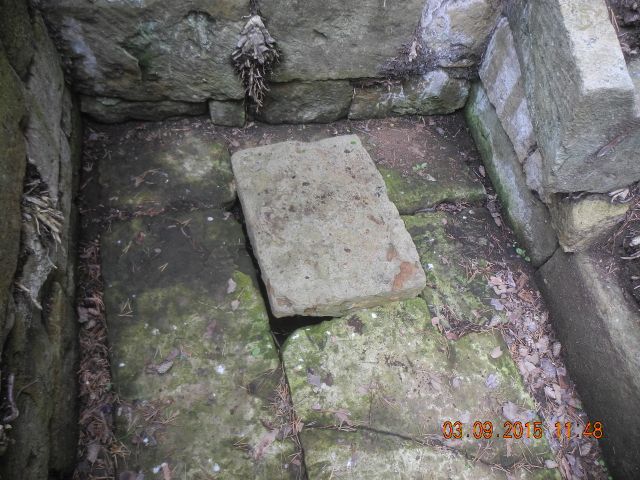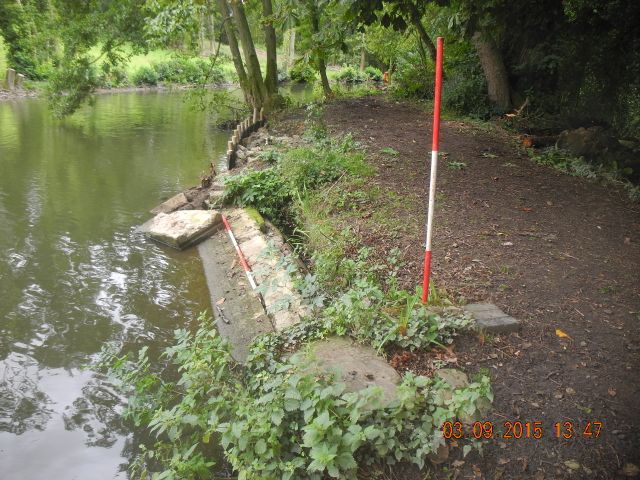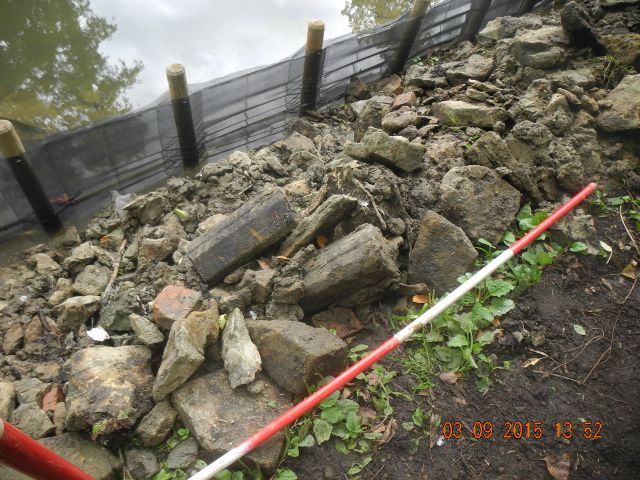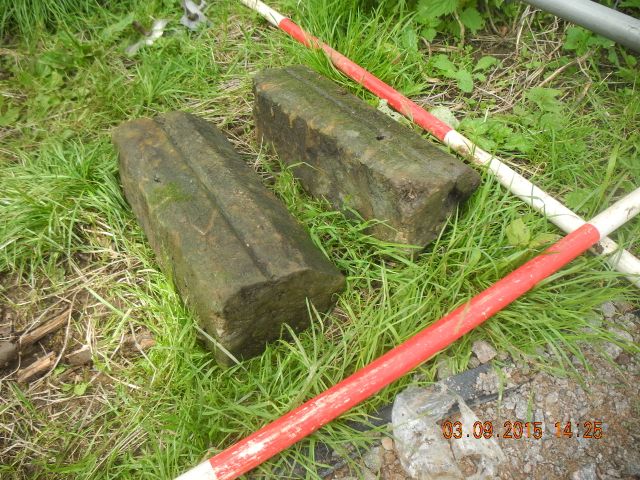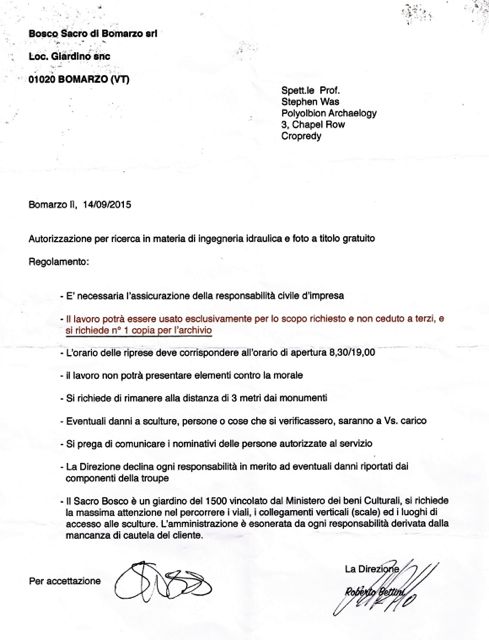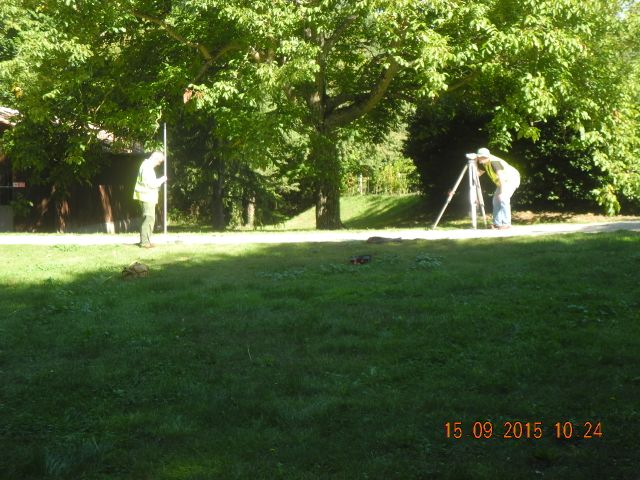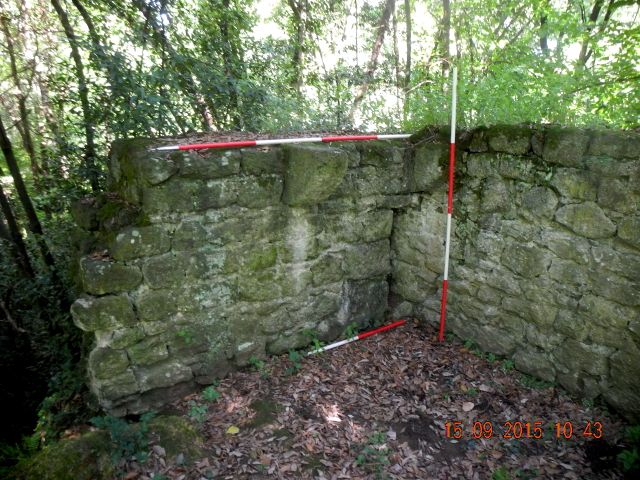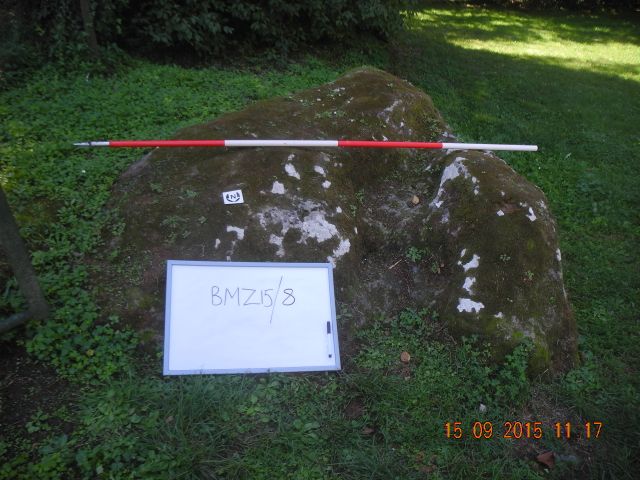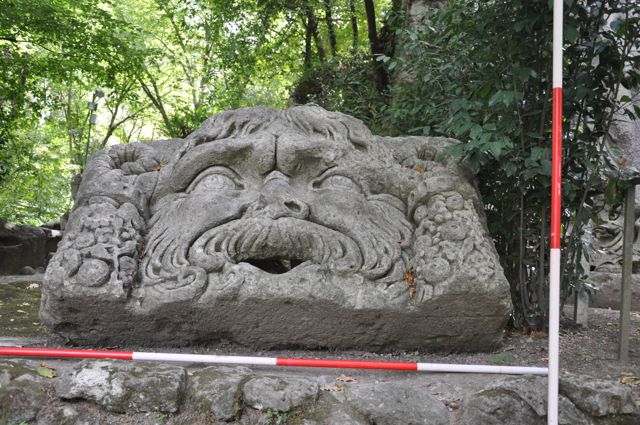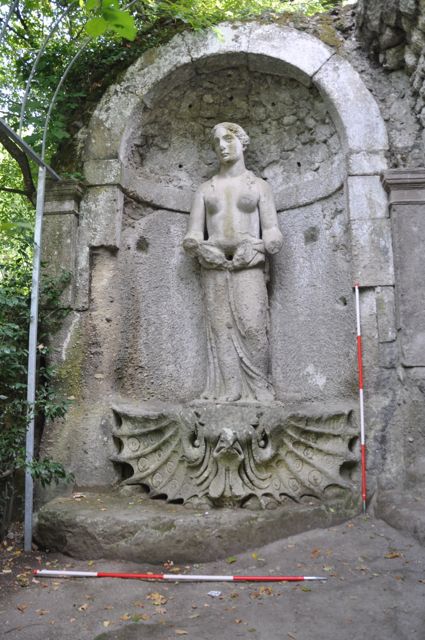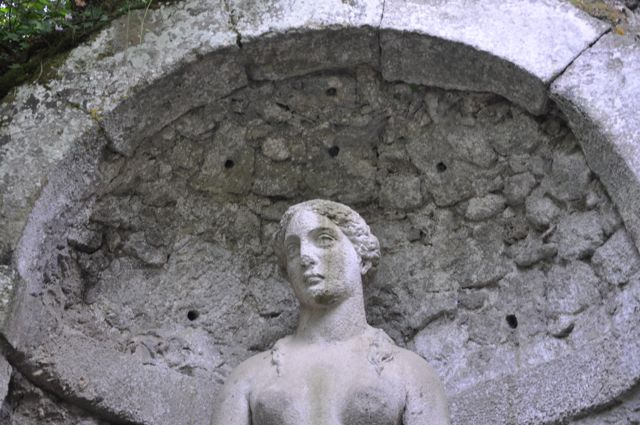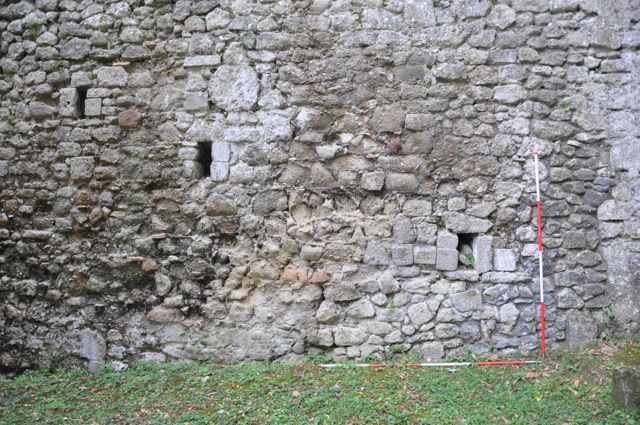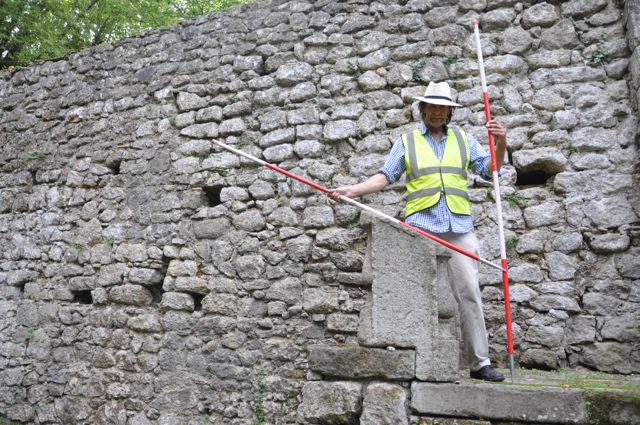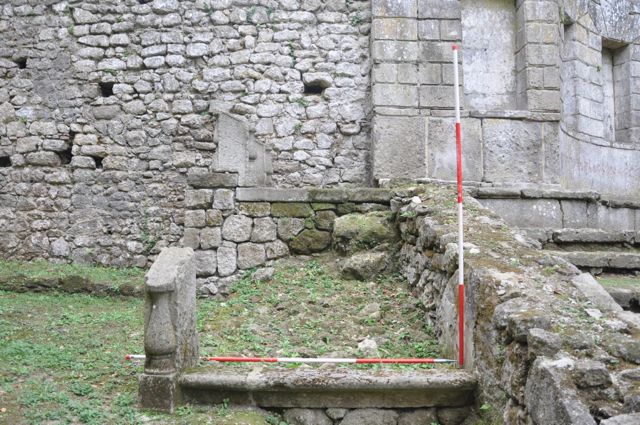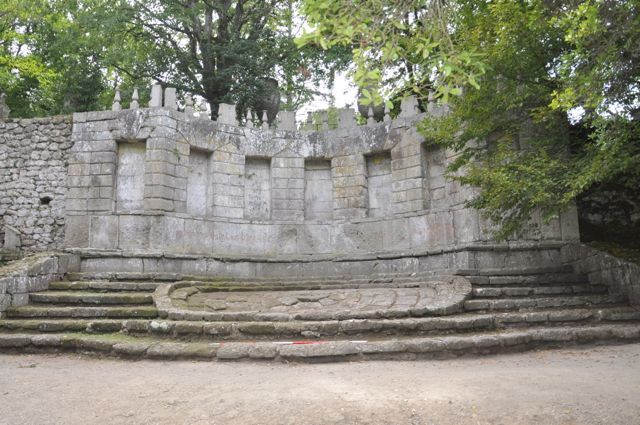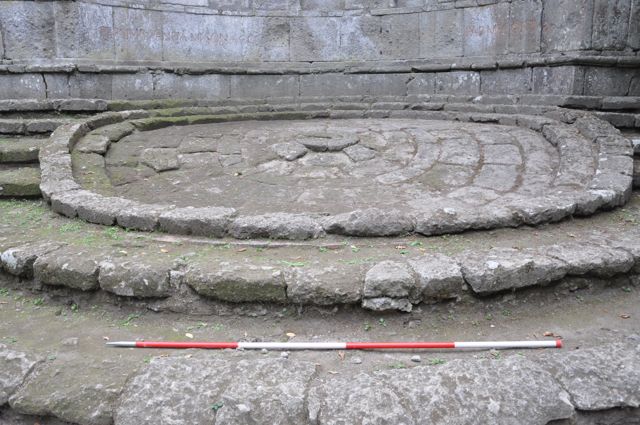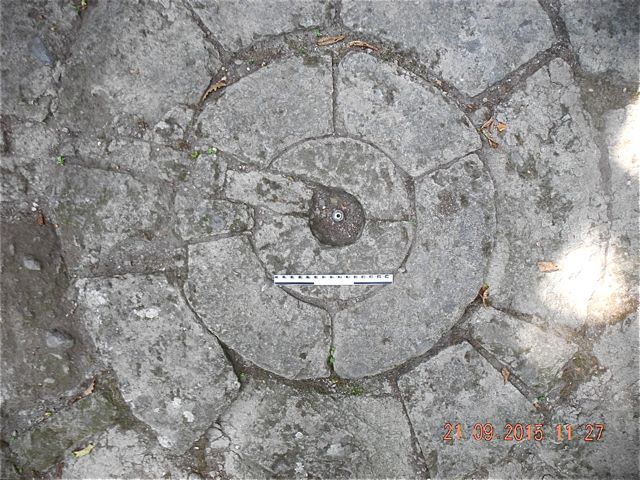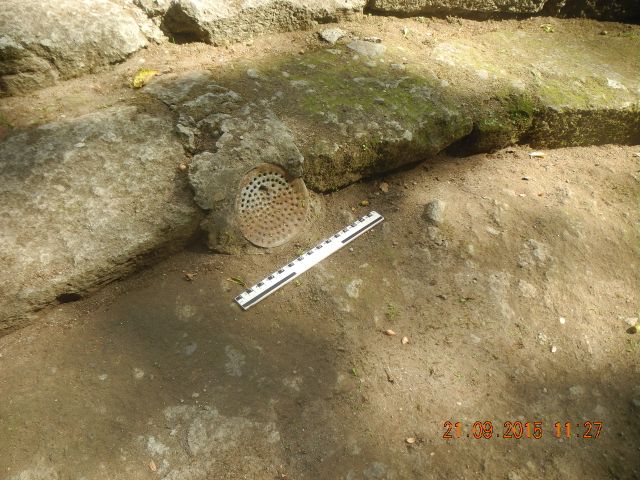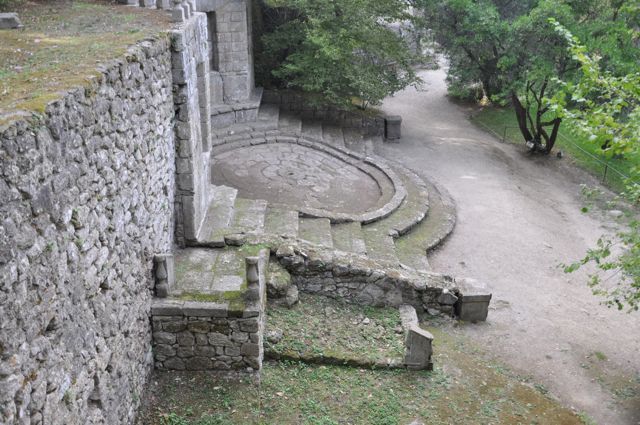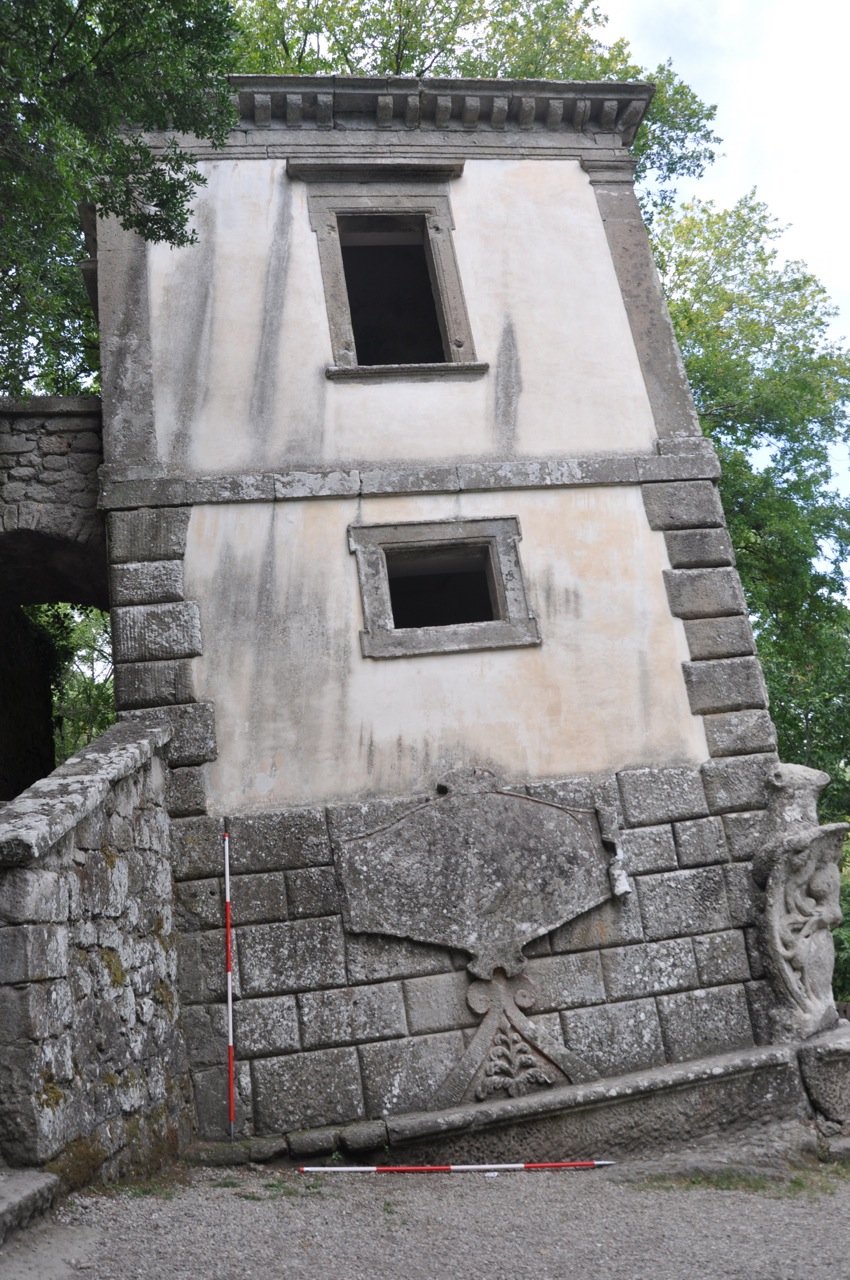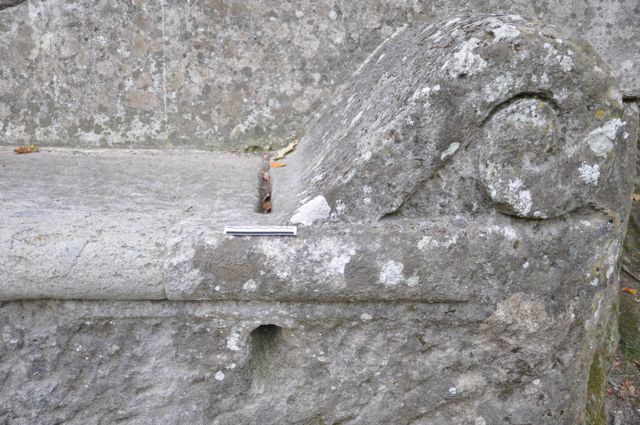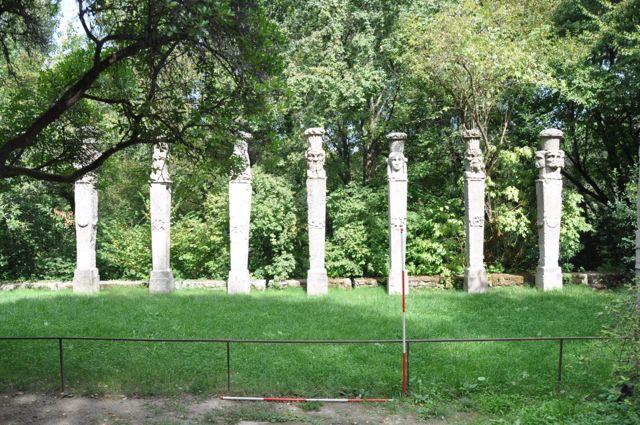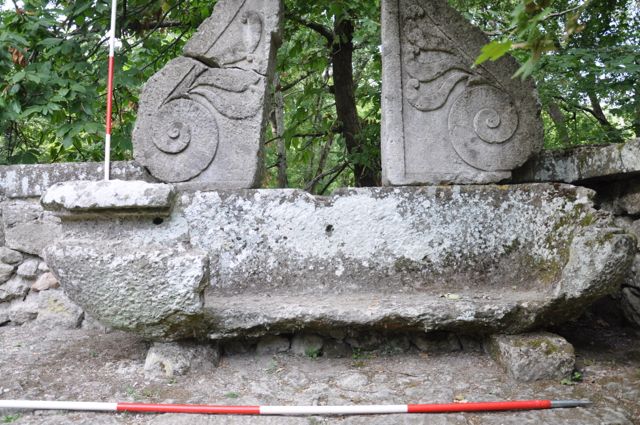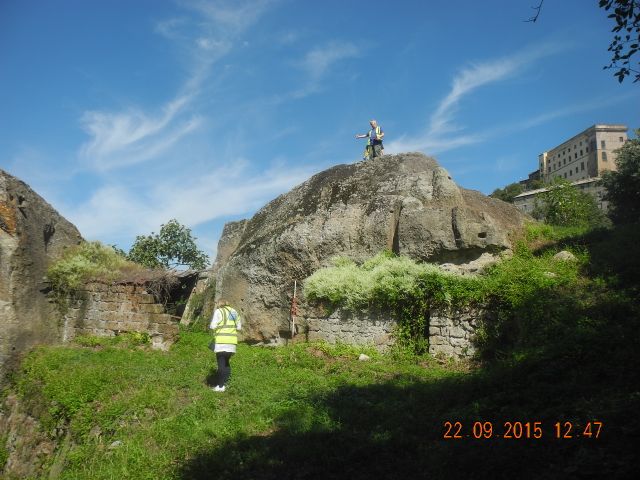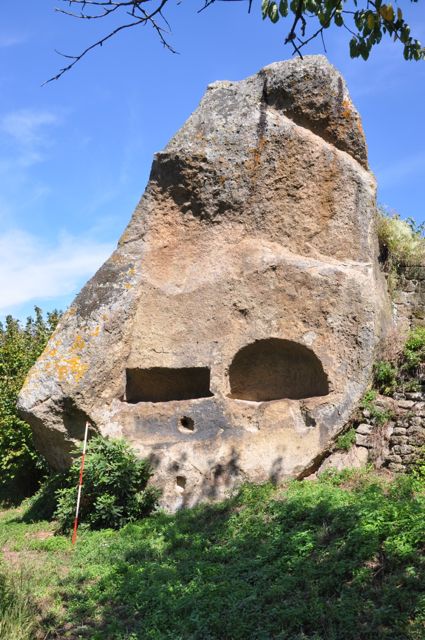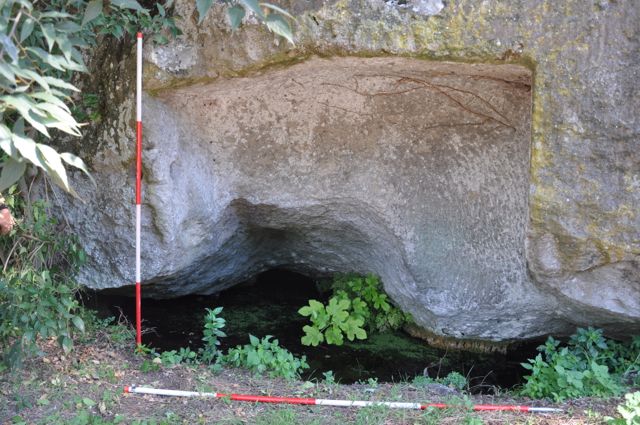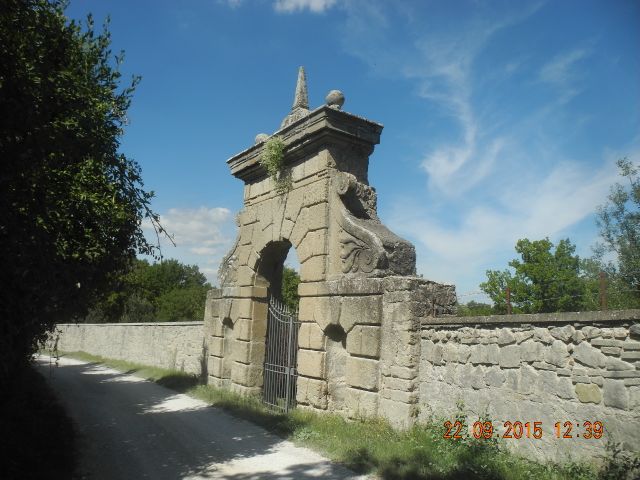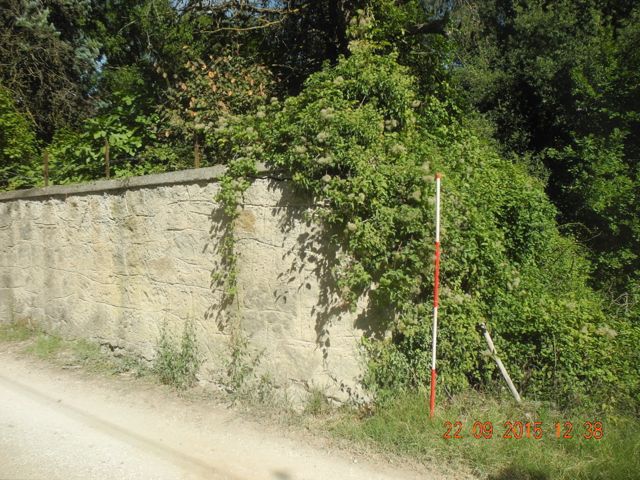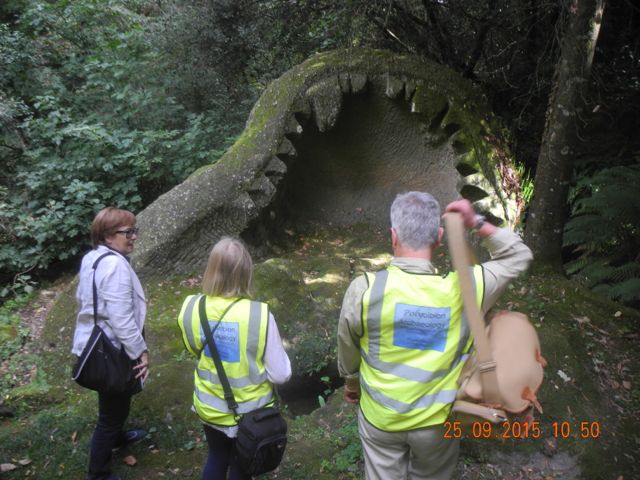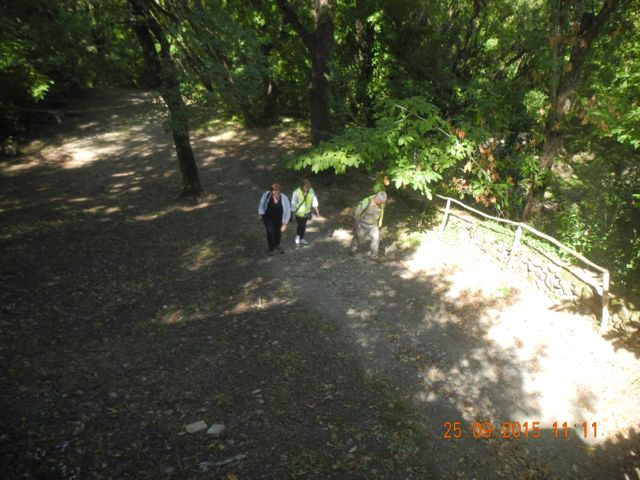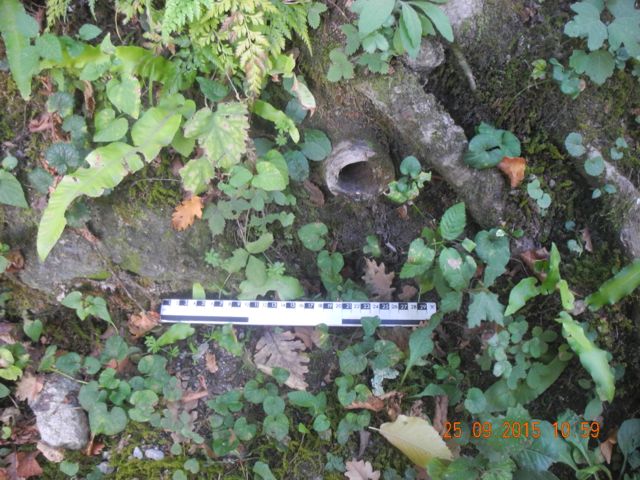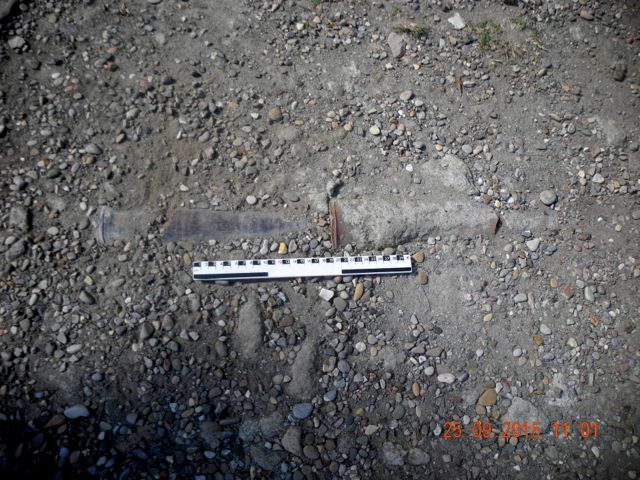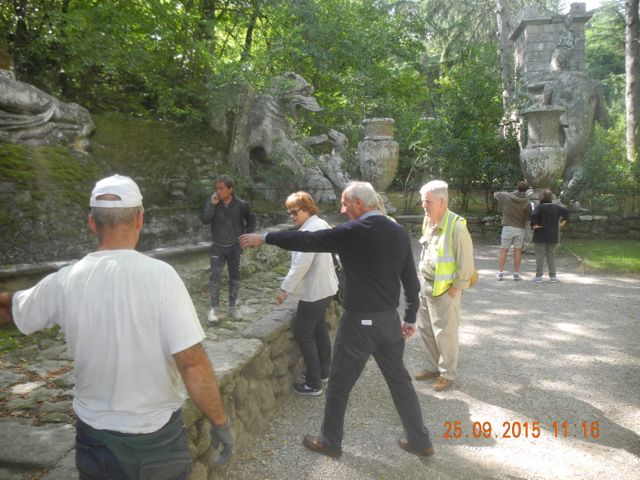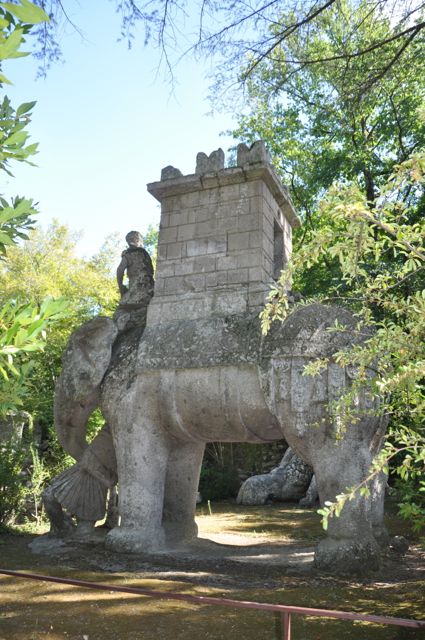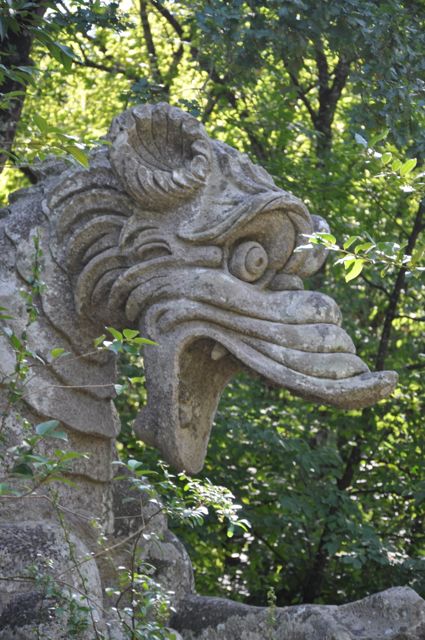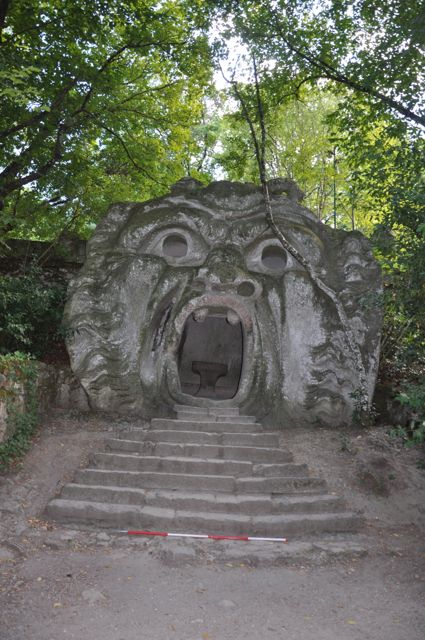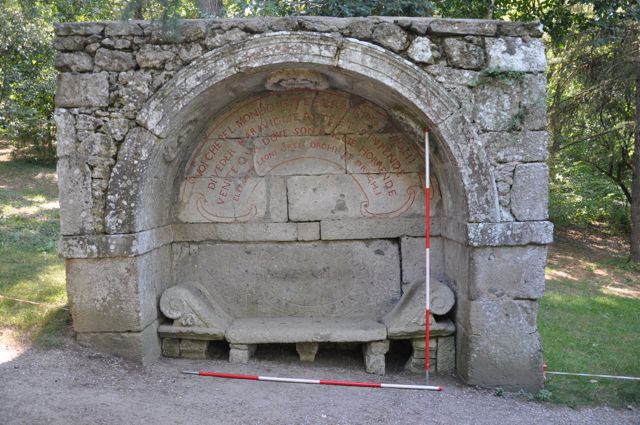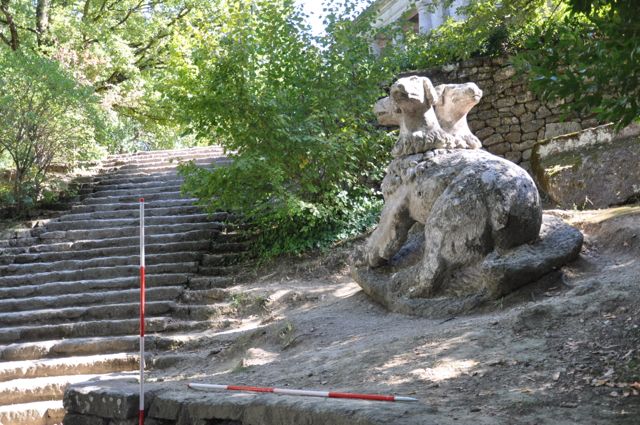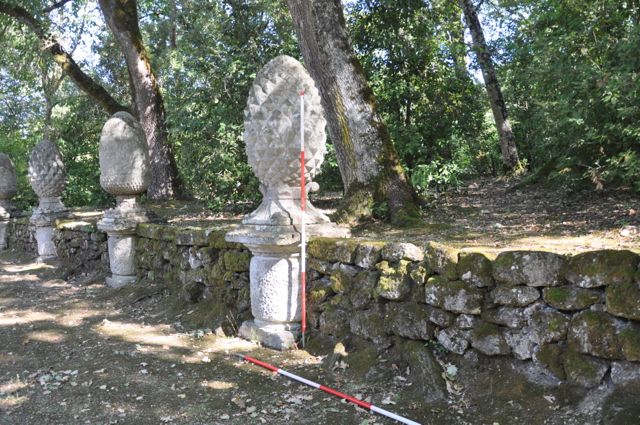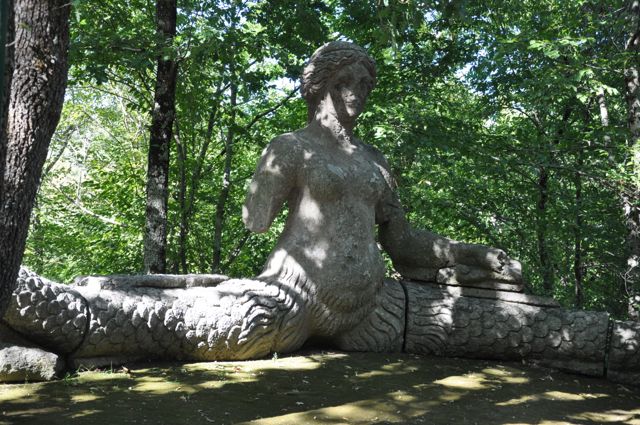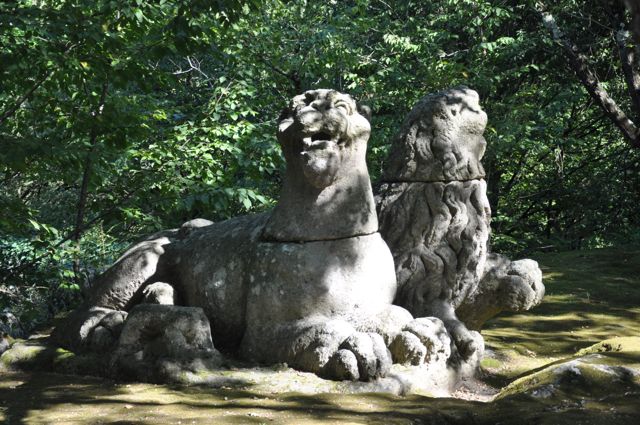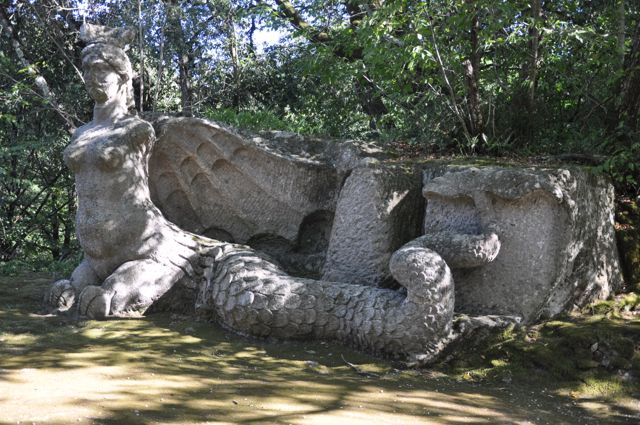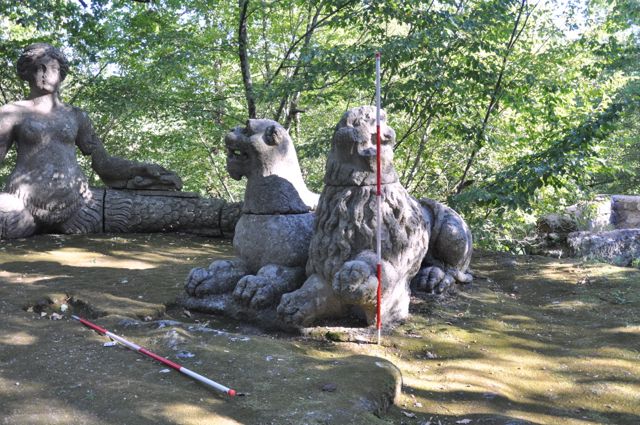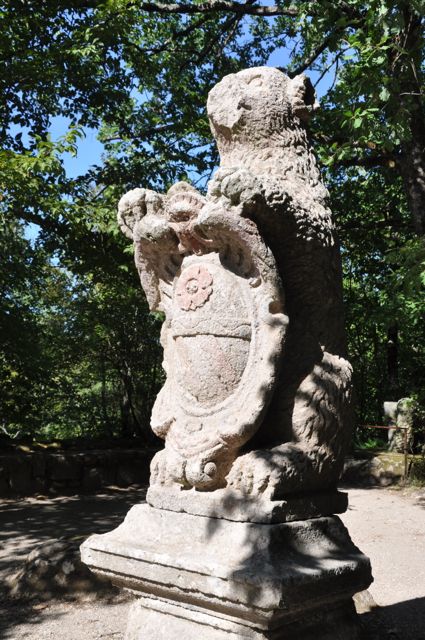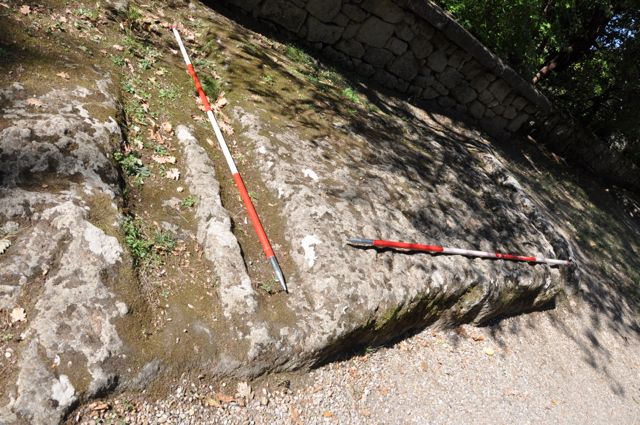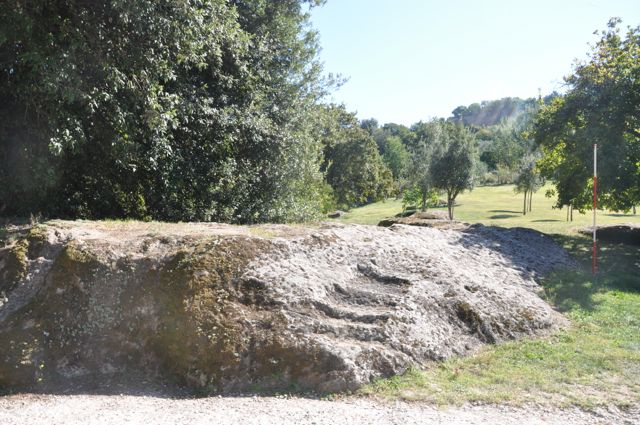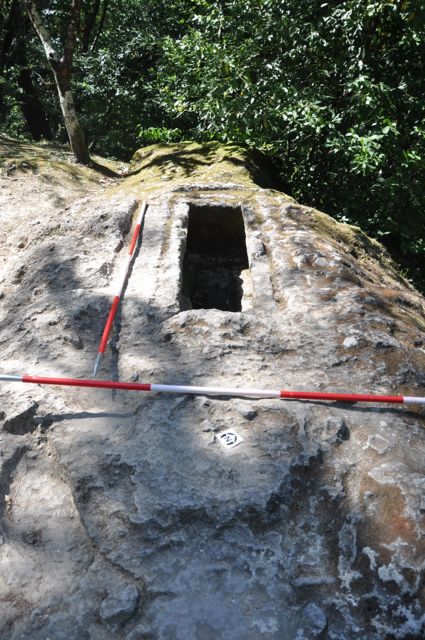The sluice at the far end of Sourland Pool: the outfall looking east and the intake looking south.
Lazio 2015
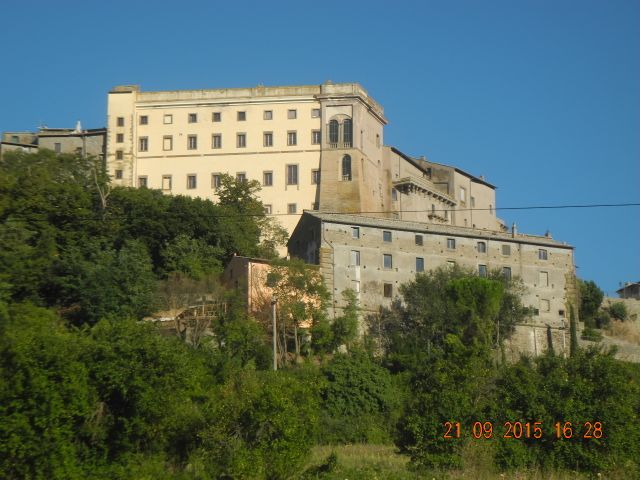
The Orsini Palazzo at Bomarzo, where it all began, view looking east.
Following contacts earlier in the year with Dr. Lindsay Sharp, former
director of London's Science Museum we hatched a plan to make a series
of visits to the famous Parco del Mostri at Bomarzo in order to study
in detail aspects of water management and especially
Lindsay's idea that the park contained a number of automata powered or
animated by water. The gardens are well known for their large
collection of bizarre sculptures cut from the natural rock in the
sixteenth century at the behest of one Vicino Orsini a local nobleman
and one time soldier who between 1547 and 1583 when he died created an extraordinary landscape. The study of the
garden has in the past been undertaken on the basis of attempting to
understand the significance of the imagery and its parallels with
contemporary literary sources. Our aims were rather more modest... we
just wanted to see where the water went!
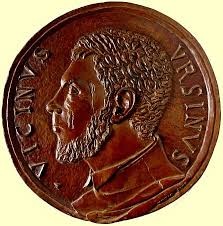
The man himself.
Monday September 14th.
After gathering everyone together Verna, Michael and Lindsay and I
left for Bomarzo traveling down towards Viterbo then on to a
small motorway heading east. We drove down through the outskirts of
Bomarzo to park up in reasonably quiet and spacious car park at the ‘Park of
Monsters’. Inside the rather attractive new visitor centre with shop and
small café we handed over the email from Signor Bettini to a lady in the
ticket booth who produced a memorandum of agreement for me to sign
promising, amongst other things, not to undertake any immoral conduct!
By this time one of our Italian contacts, Federica, had also arrived to come round with us. So on to our first visit to the
Sacro Bosco. We spent a couple of hours looking at peripheral features:
sites of pools and other tanks and worked boulders, although the dating was clearly
problematic. Then we worked our way down into the better known areas of
the site: through a possible lake – now dry, past an inscription ( as
adopted by Polyolbion Archaeology) and into the extraordinary
collection of sculptures and fountains and more sculptures and
fountains all set amongst curiously formed boulders of massive
dimensions. This was very much by way of a preliminary inspection to
get our bearings and to get a grip on the scale of the task before us…
and what a task. One thing that became clear very quickly was that this
was a multi-period site, not only with respect to alterations during
the sixteenth century but also the presence of earlier remains,
Etruscan, Roman, early Christian and so on plus later modifications. We returned to the visitor
centre for lunch around 1.30 and said farewell to Federica and
boyfriend then after lunch poked about up the road a little picking out
more boulders, with and without cisterns and other features. We returned
to the main park for another hour or so whilst I contemplated the
opening shots of our campaign to record the key water features across
the whole park.
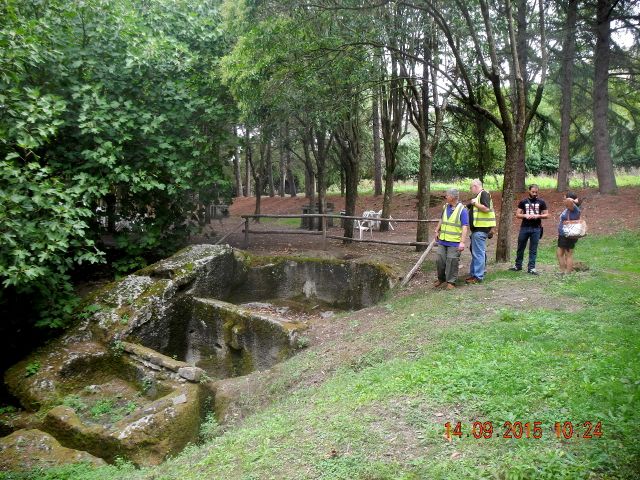
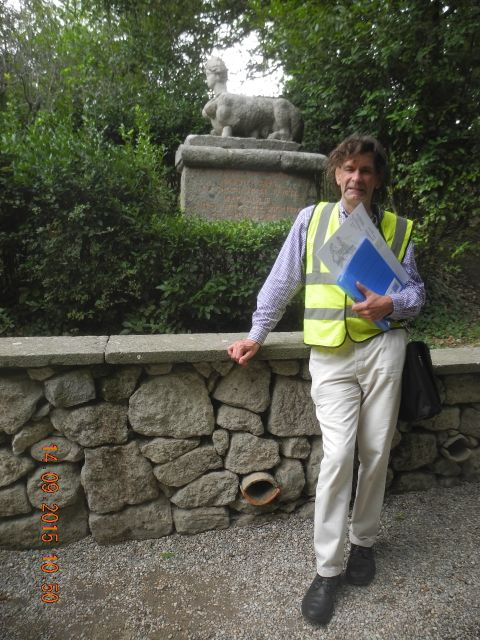
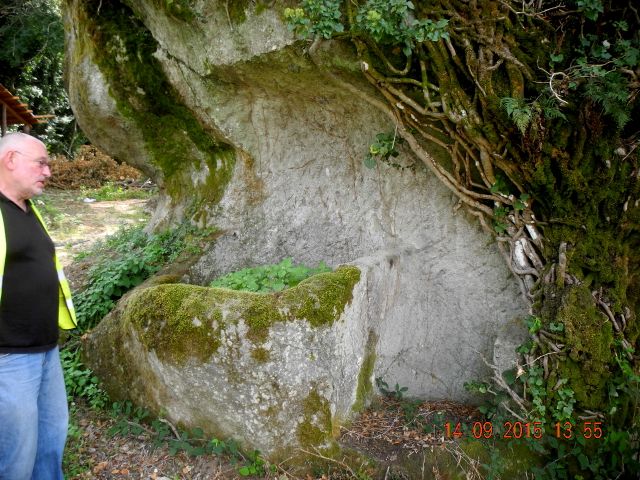
The opening day of the campaign: taking a look at a series of stone
tanks, posing proudly in front of '
Mente parte a parte' and Lindsay off
piste with more worked stone.
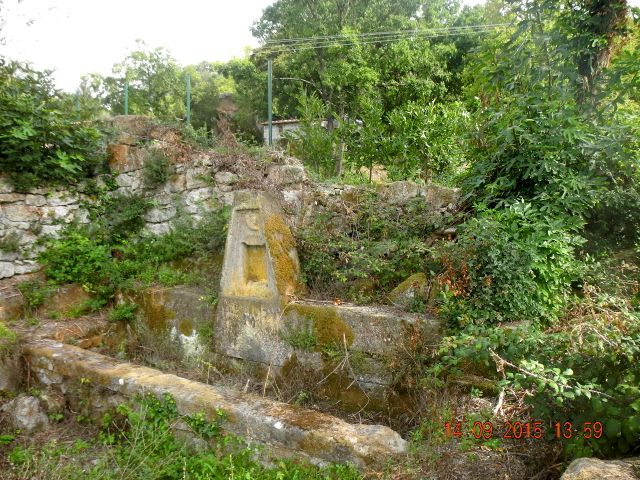
I took a stroll a little further down the lane to take a look at this drinking trough.
|
A note on Nomenclature
There are no agreed sets of names for the various features within the
garden found in the published literature about the site. For our purposes
we rather unimaginatively numbered everything with the code BMZ15 then
with individual monuments being sequentially numbered with particular
features labeled alphabetically, hence BMZ15/29d is a later cut in the
stone to drain the basin below the Pegasus fountain. For verbal
descriptions I have stuck with names as printed in the official
guidebook as sold on entry to the park entitled:
BOMARZO
THE PARK OF THE MONSTERS
realised in 1552 under the name of
VILLA OF THE WONDERS
ALSO CALLED
THE SACRED WOOD
AN ARTISTIC AND CULTURAL COMPLEX
UNIQUE OF ITS KIND IN THE WORLD
|
The first working day at Bomarzo began at an area generally
viewed as the site of a lake. It lies at the southern end of the garden
and was defined by an unconvincing series of walls and terraces and was
reportedly held in check by a stone dam to the north. On the west side
was a short section of wall pierced by a castellated archway with a
small stone hut attached on the south side. It all looked terribly
convincing but didn’t appear on any of the published plans, hmmm…
Michael and Lindsay spent their day mastering the art of leveling and
produced profiles running north to south and east to west across the
area whilst Verna recorded the features of what was to be the first of
a series of worked boulders and associated low walls. I began a 1 to 10
elevation drawing of the wall identified as a dam. Unfortunately it
contained what looked like an embrasure closed by a large vertical
stone pieced by three circular holes one above the other. Lindsay saw
it as a point at which pipes could have been taken out but I wondered
about early loopholes for guns. It was very strange and although there
was some evidence that a couple of the lower stones had been water
eroded it was not consistent. Indeed looking west along the line of the
dam this major wall did not appear to continue all the way across
although it was backed for some of it’s length by a subsidiary wall
that looked rather casually thrown together and later and not up to the
job. Was there really a lake here?
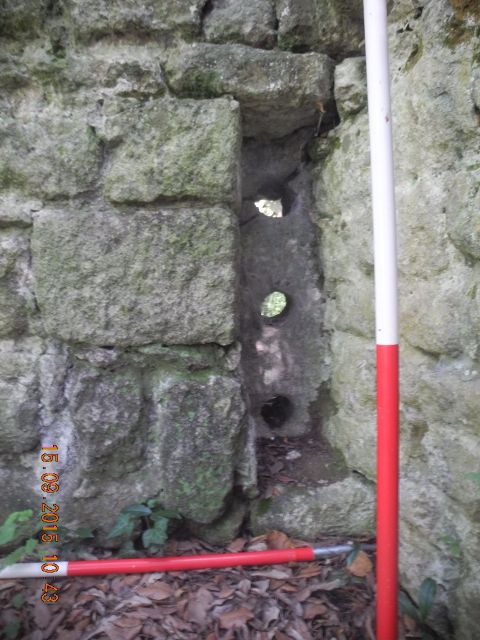
Detail of embrasure with holes, view looking north.
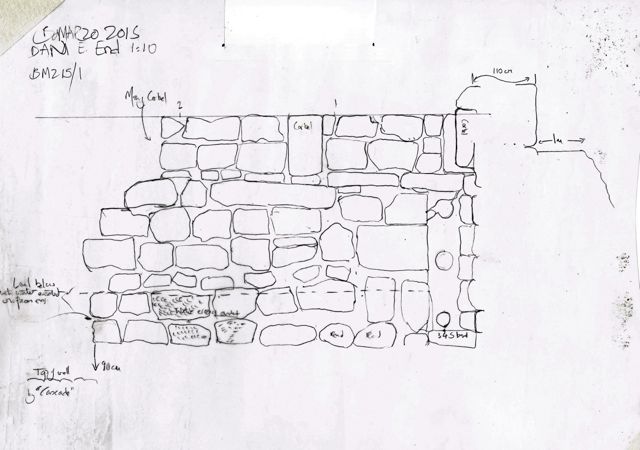
Stone by stone field drawing of BMZ15/1, let's just call it a wall for now.
In the course of exploring the setting for this wall I worked my way
round through the undergrowth past a quite spectacularly shaped boulder
down to a section of wall which seemed to line up with our dam.
Climbing up to confront the downstream side of the structure it turned
out to be even more complex and so merit a return visit to draw this,
stone by stone. Meanwhile Verna had completed the survey of the archway
and hut and Michael and Lindsay had finished a cross section of the
valley. It was time to stop. It had been a slightly slow day but we
were all learning and adapting our methods to the strange environment
that was Bomarzo. And finally just as we were about to leave we bumped
into Signor Bettini and shared cordial greetings
Wednesday September 16th.
Olivier and Isabelle, our friends from Lille, had arrived the previous
evening and headed over to Bomarzo for their first visit. Once at work
Michael and I plunged into the greenwood and drew and planned the
various wall fragments to the north east of the dam and managed to
knock out a very creditable stone by stone elevation of the north face
of the dam in short order. Verna and Lindsay got round and photographed
the lakeside contexts. For lunch we met up with Isabel and Olivier and
enjoyed fascinating discussions on the archaeology of the mind of
Orsino (Isabelle’s phrase).

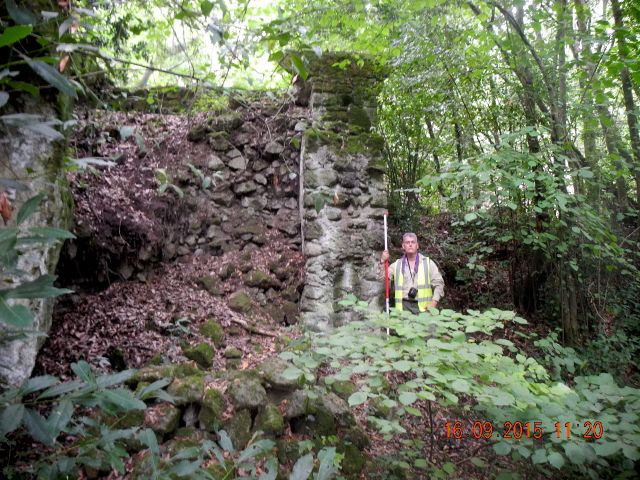
After a slightly perilous scramble here is the view of the north face
of the dam wall looking south, note the straight joint to the left of
the embrasure and here is the east end of same wall looking west
with a massive amount of made up ground behind it and Michael looking quietly heroic.
THIS PART OF THE GARDEN IS NOT OPEN TO THE PUBLIC
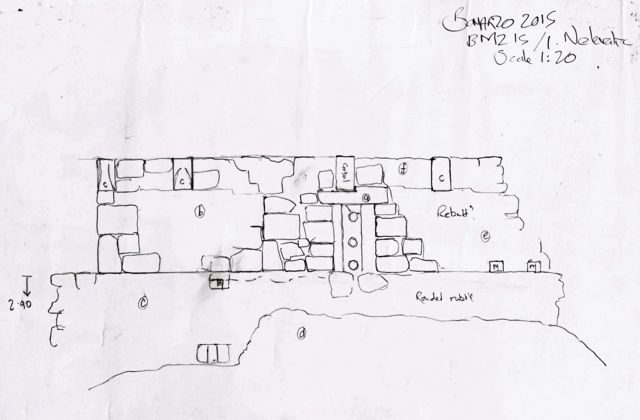
Field drawing of BMZ15/1, north elevation
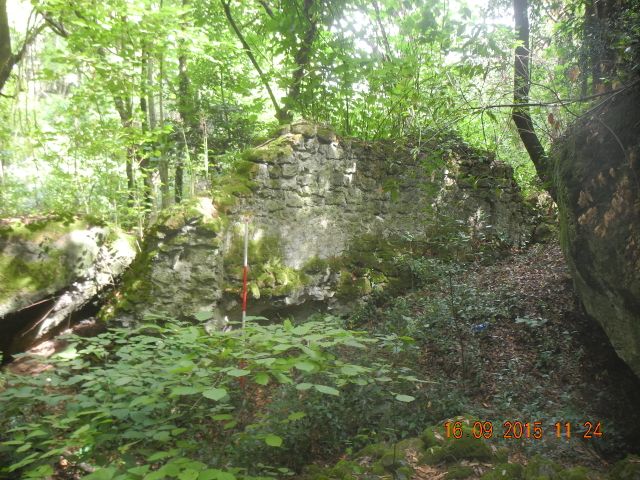
The the east of the dam is a curious curving wall BMZ15/14 which
bends round and slots in to another worked boulder further to the east.
The afternoon saw Michael and I heading up to the head of the lake and
doing our best to survey using a range of cunning methods, and from a
distance, the upper cascade and associated pool and steps and walling.
Verna and Lindsay worked hard on a detailed plan of a worked boulder
that seemed to bear some relation to the walling north east of the dam.
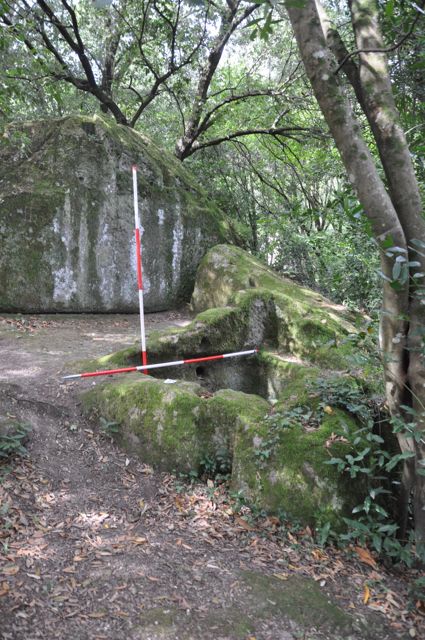
Verna and Lindsay's boulder BMZ15/16, view looking west.
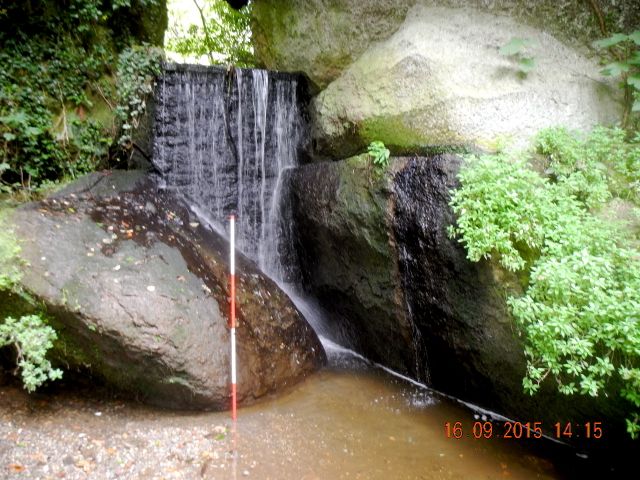
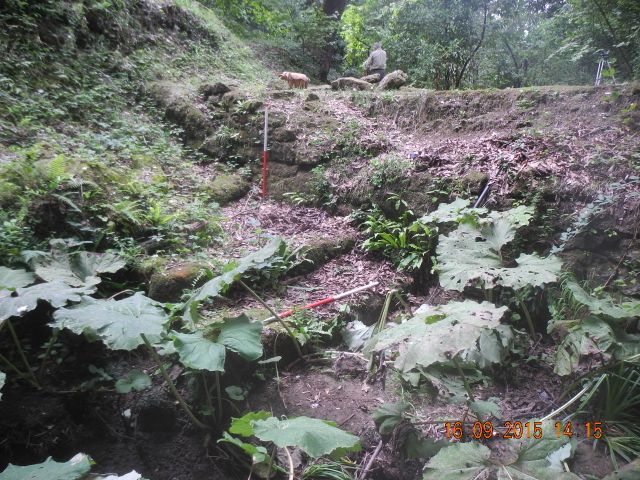
The water enters the park at the upper cascade BMZ15/17, view looking
south, where it enters a stone edged basin approached by steps
BMZ15/18, view looking north west.
As the day drew to a close Michael and I headed down the valley and
dropped in some additional temporary site data and got as far as the
steps down to the terrace of the wrestling giants or whatever. Here was
a nice little bit of structural evidence to be observed. Currently the
descent is made by steps but there was an evidently new section of
masonry which narrowed down the staircase and a curious corrugated
ledge cut in the rock face along side. Back tracking a little it was
clear, because the upper portion survived, that access to the lower
terrace was via a ramp with stone strips acting as stops at regular
intervals. This turned to the north at a landing but had been cut away
and replaced by steps in order to clear the face of the stone for a
large inscription. However, a line of fairly large stones looking like
foundations suggested the width of the ramp as it turned and headed
north towards the gigantic wrestlers.
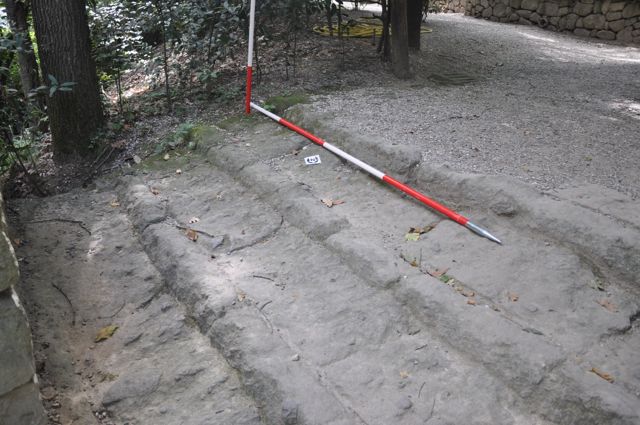
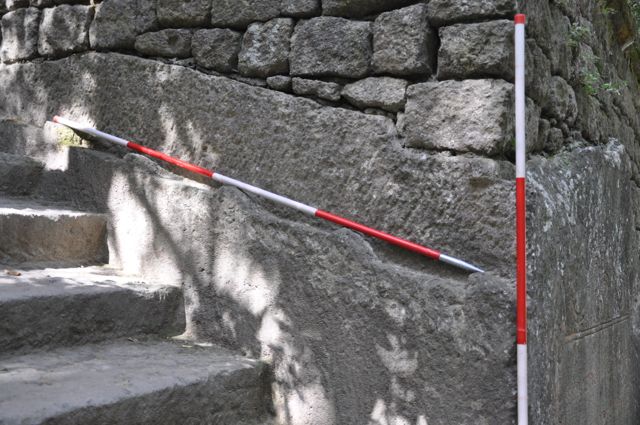
Observations on the steps down to Giant's Terrace, BMZ15/22b remains of
the original ramp looking south with traces of the ramp where it has
been cutaway to the east, looking north west.

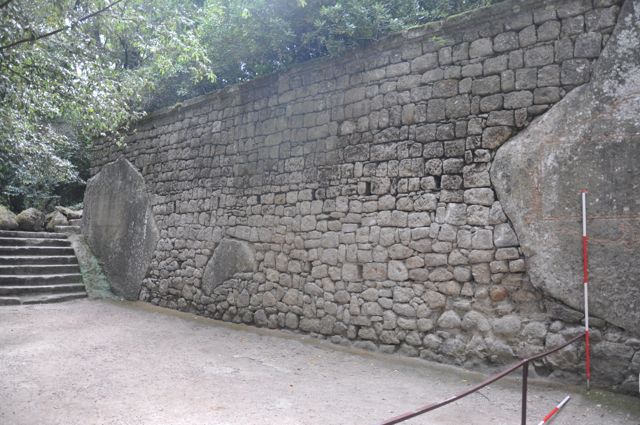
At the foot of the stairs are a line of large stones BMZ15/15 which may
represent the foundation for the ramp cut away at a later date to permit
the inscription on the terrace wall.
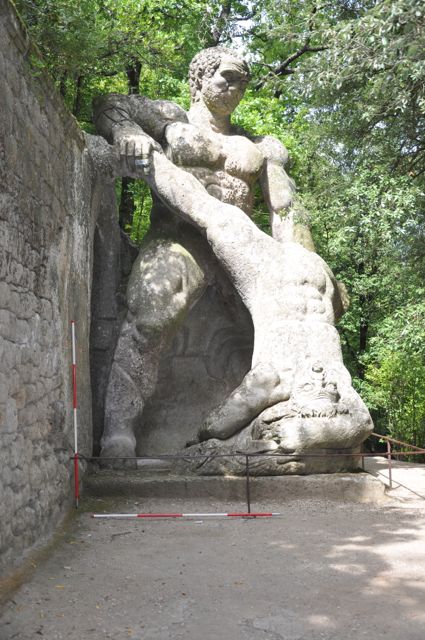
And here they are, the famed wrestling giants... or BMZ15/23 as we like to call it... , view looking north.
Thursday September 17th. Villa Farnese, Caprarola
Friday September 18th.
We returned to Bomarzo suitably inspired by the gardens of the Villa
Farnese and keen to track down manhole covers, sockets for taps and
what have you. My time was spent in producing some reasonably
detailed plans of the so-called lake, still big question marks about
this, the worked boulder above the so-called dam (ditto.), the walling
next to the arched entrance, the steps down to the giant’s terrace and
possible site of ramp, the so-called dam itself ( ditto, ditto) and
then, mainly after lunch, the Pegasus terrace with eponymous fountain.
This proved to be an extraordinarily complex series of mini-monuments
packed into a small area, probably something like 20 individual
contexts. Verna spent the day photographing the same area in enormous
detail whilst Michael and Lindsay worked heroically leveling nearly
thirty spot heights on the upper two terraces. As part of their
explorations they did come across an intriguing stone lined depression
which could potentially we a conduit feeding into one of the grotesque
mask fountains.
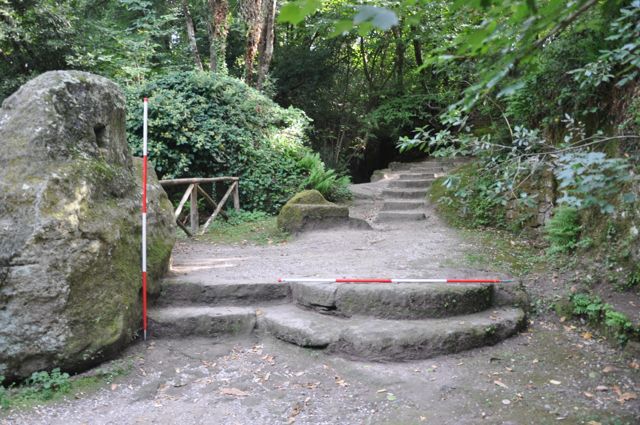
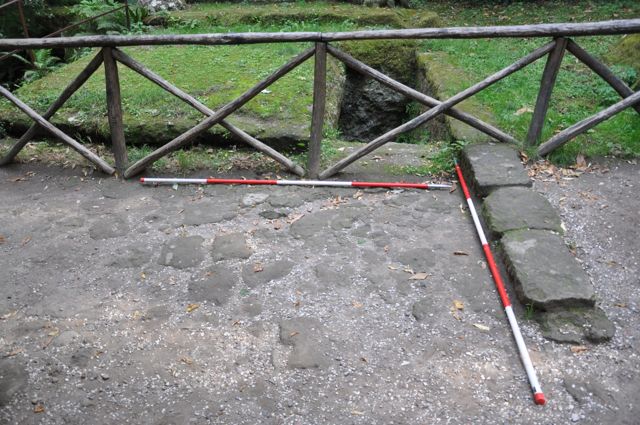
Steps BMZ15/24 down to the lower terrace by the Pegasus Fountain,
looking south and more steps BMZ15/27 down to the tunnel in front
of the Tortoise looking south, not sure what is happening with the wall
on the right.

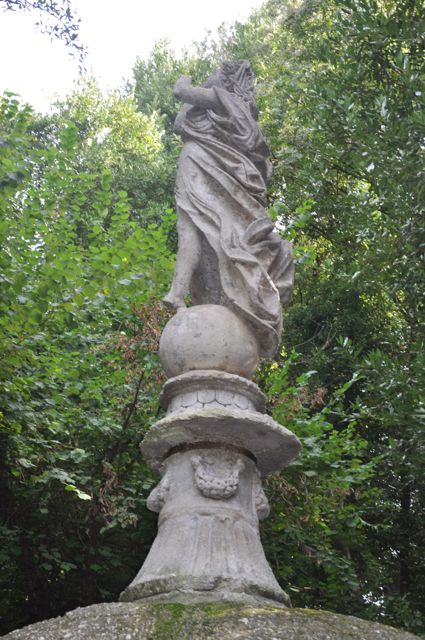
The Tortoise with Fame on its back BMZ15/26, views looking south. We had
the notion that fame could have spouted water out of her trumpets (as
at Villa Garzoni)
which would then have sprayed down into the mouth of the Orca in a
satisfying way possibly then swirling round and out to soak suitably
positioned spectators.
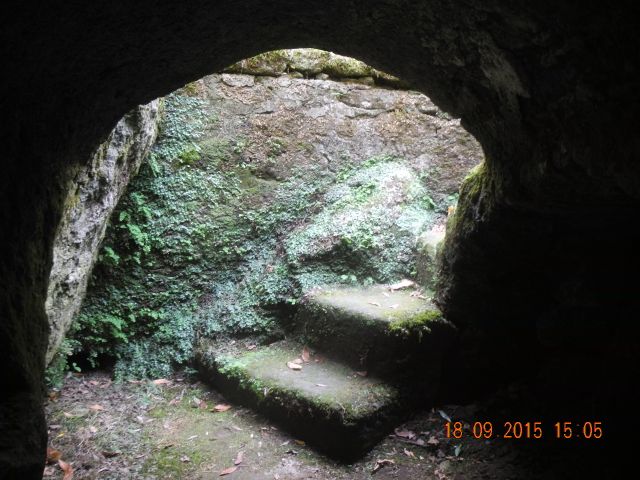
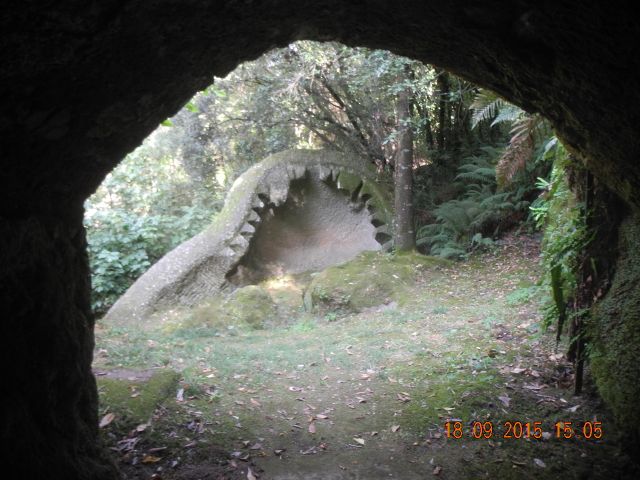
View looking west of the steps down in front of the Tortoise and the
moderately scary view you get of the Orca's mouth as you turn the
corner.
THIS PART OF THE GARDEN IS NOT OPEN TO THE PUBLIC
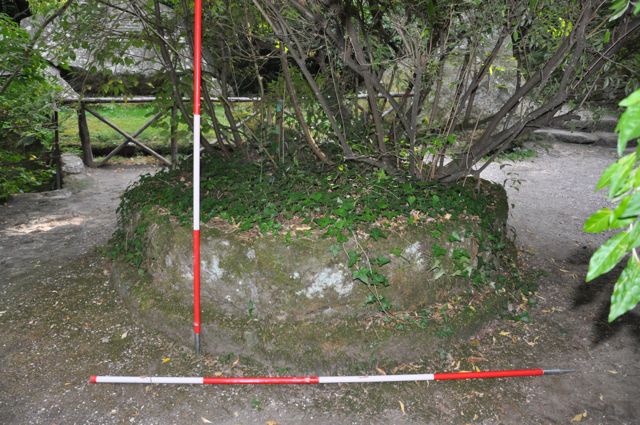
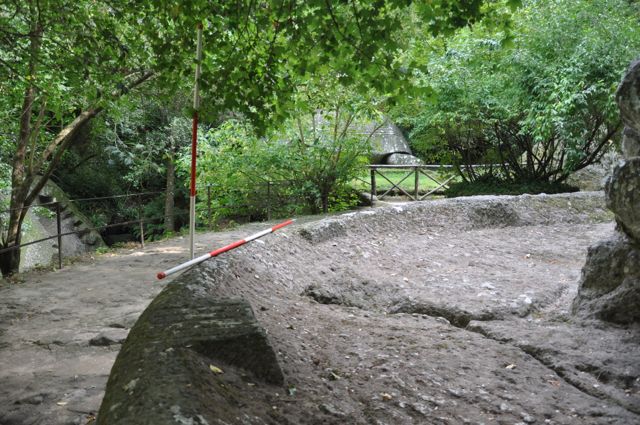
Between the Tortoise and the Pegasus Fountain is this
curious circular 'planter' BMZ15/28,
The eastern lip of the Pegasus Fountain showing the
emplacements
view looking south, there is another one on the
slope below the Rotunda
for the statues of the
muses and the later cut BMZ15/29d to drain the
and indeed one on top of the Rotunda
itself, made of separate stones,
basin of standing water.
they don't look to have held water so what were
they?
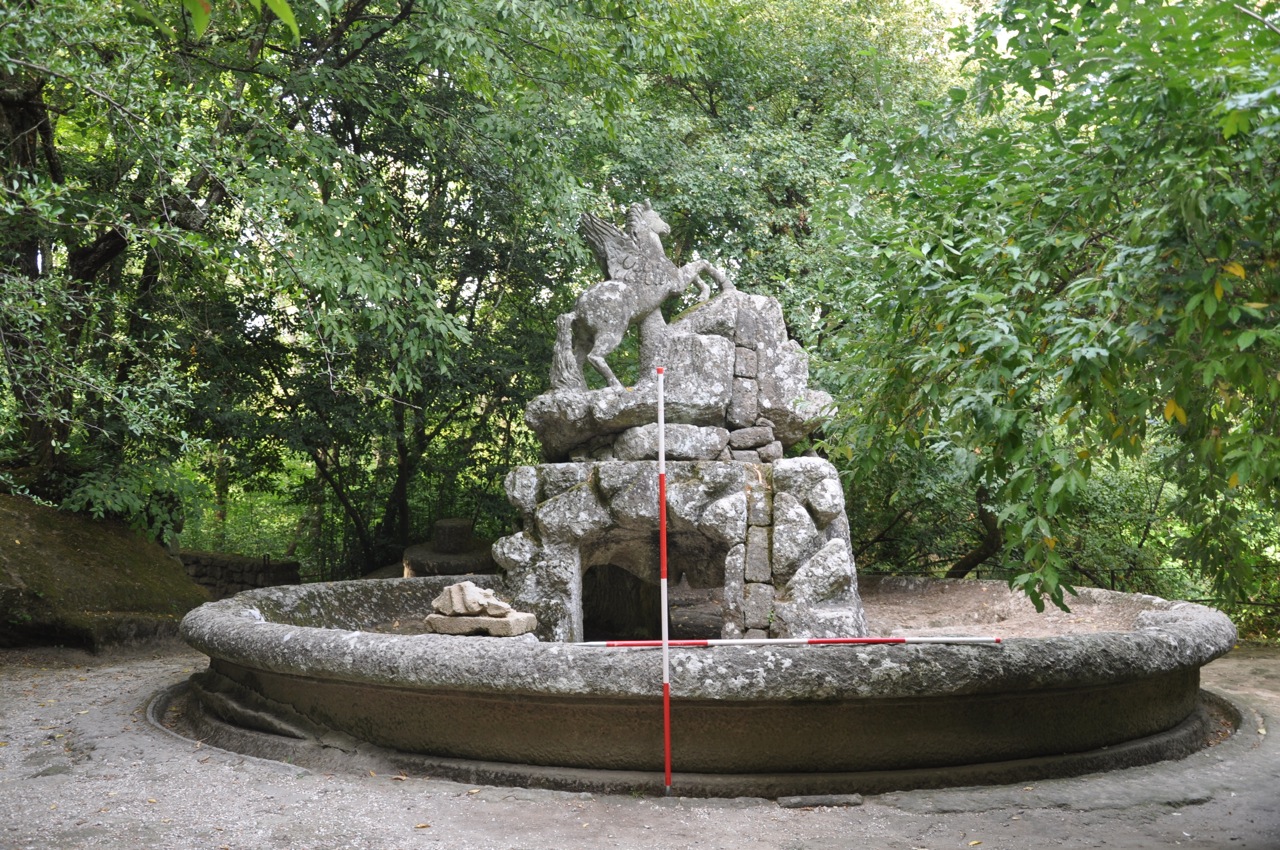
The Pegasus
Fountain BMZ15/29 view looking north west and showing the stone
blocking to the housing for the fountain's pipework. Much has been
written about the famous tilt to the basin but I
wonder if it is simply the result of an earth slip, note the way it
seems to have broken away from its base on the left hand side.
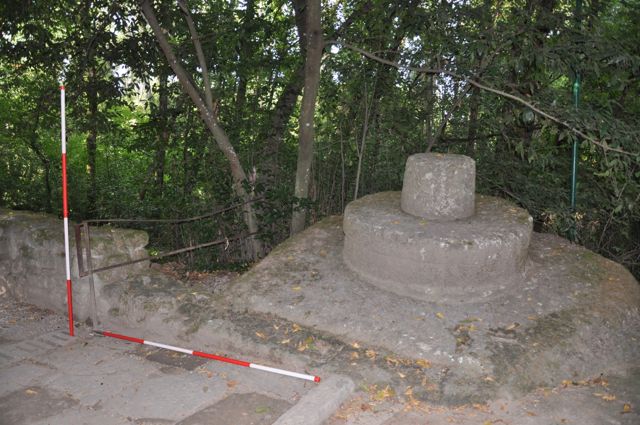
Another curious feature BMZ15/30 described by some as a column base it
looks like a pair of millstones to me, again on something of a tilt,
looking north east.
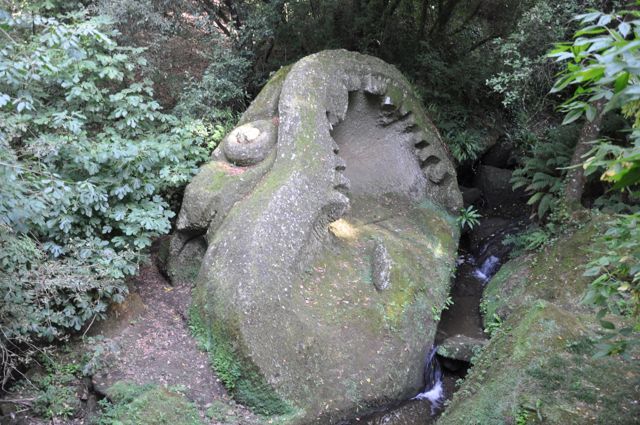
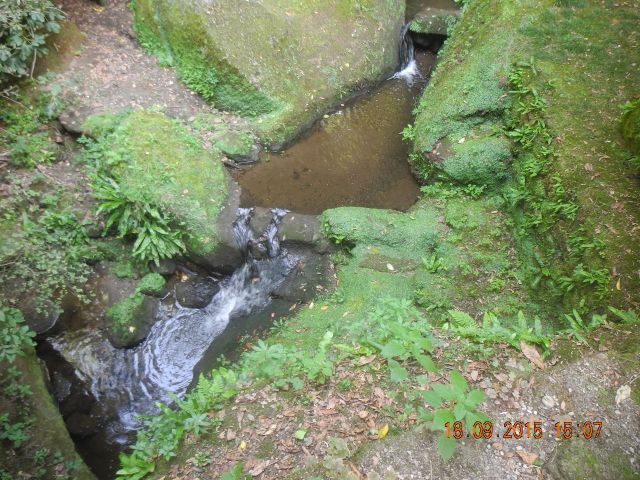
A view of the Orca from the terrace next to the Pegasus fountain and
the site of a possible small dam to bring the water level up to the
Orca's chin, both views looking south east.
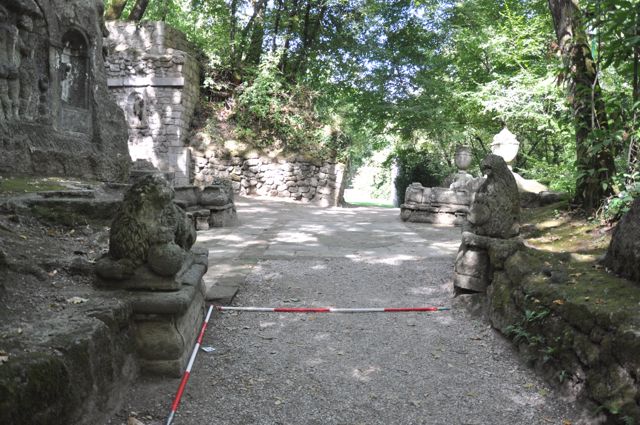
Looking north west along the terrace from the Pegasus Fountain into the Nymphaeum.
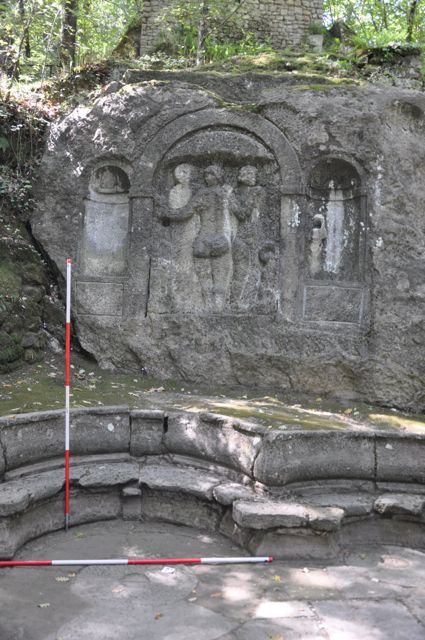
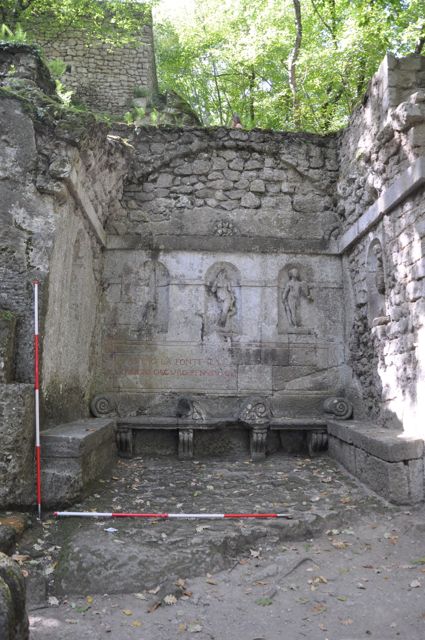
In the Nymphaeum: seats backed by the three graces BMZ15/35 and round
the corner more benches plus nymphs BMZ15/34, both views looking south
west.
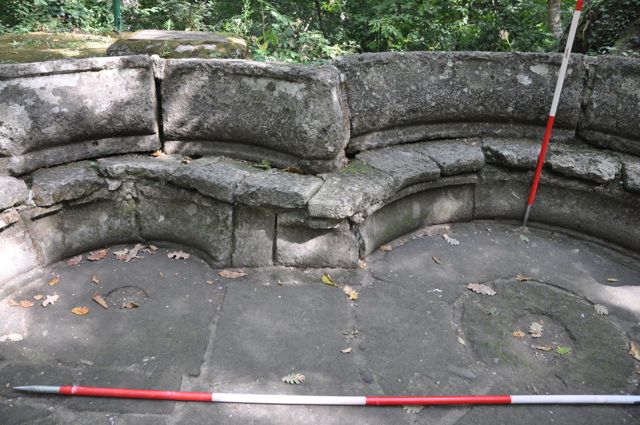
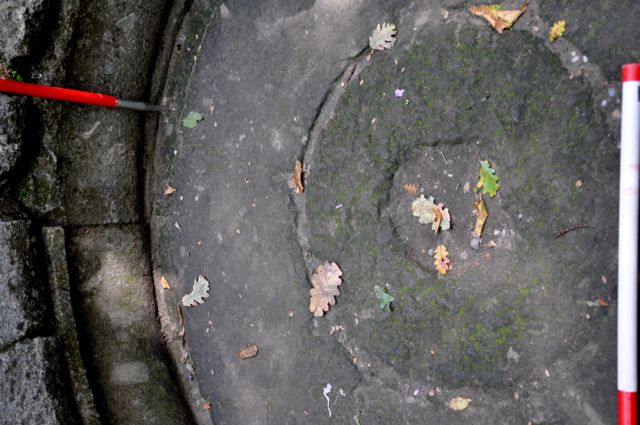
Detail of seats in the Nymphaeum BMZ15/33, north east side. We
suspected initially that the central roundels may have been the site of
a series of small fountains but absence of suitable drainage facilities
make this unlikely.

The Dolphin Fountain BMZ15/36, view looking north

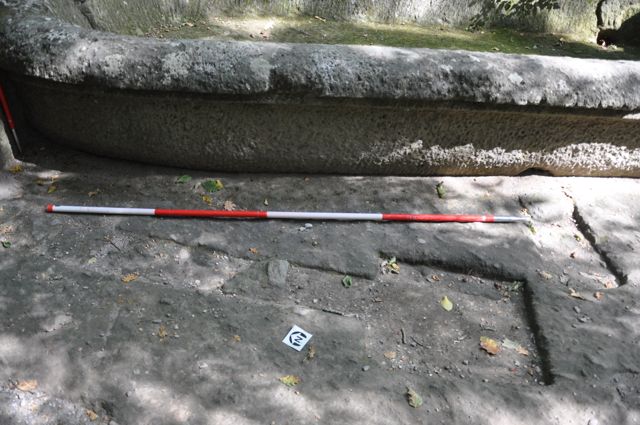
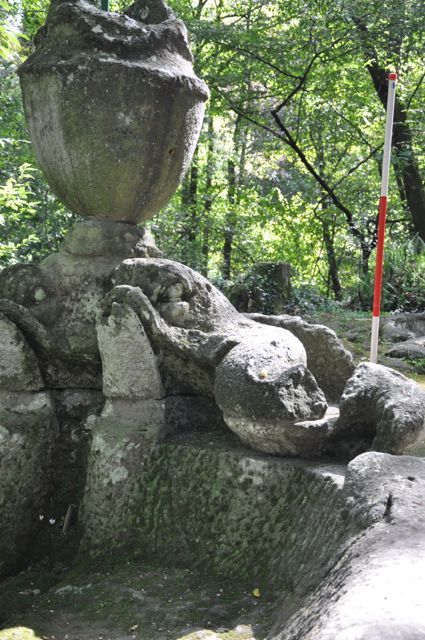
Details: BMZ15/36b stones closing cut for pipes, BMZ15/36c square
depression and channel in front of fountain and a dolphin and urn at
the south east end with stub of pipe.
Saturday September 19th.
The day began, unusually, with a demonstration of drone flying around
the farm house by Marcus, one of Lindsay’s friends, Marcus, from
Sweden, showed us a very impressive piece of technology but a little
frightening. In flight it sounds like a crowd of angry bees. Lengthy
conversations about the legal implications of operating this equipment
rapidly lead to the conclusion that it was not for everyday use.
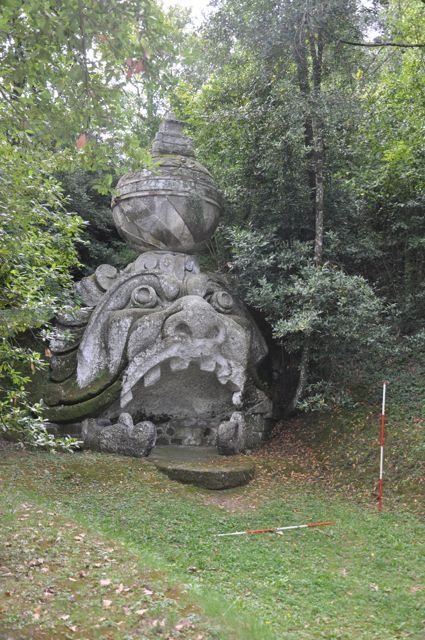
Not my reaction to low flying drones but the Mask of Proteus-Glauco
BMZ15/19 viewed from the north with site of a shallow rectangular pool
in front of it.
Off to Bomarzo for around 11.00 p.m.. Verna continued her mission to
photograph the extant monuments whilst Michael and I worked with the
level to put some points down across the stream on the east side of the
valley. Lindsay arrived a little later and set to work planning a small
series of stone carved tanks set amidst what looked a little like a
formal sixteenth century garden replete with terraces and rectangular
pools. I then continued with my campaign to produce a series of
annotated plans from the lowest terrace. Probably the most significant
‘discovery’ was the base for a set of steps going up from the terrace
containing the repositioned Hermes to the terrace next to the river
god. A close examination of he sleeping nymph and the folds of
her drapery provoked a discussion regarding the importance of ensuring
natural drainage off the surface of sculptures, could these be chasings
for pipes? Probably not. On a brief expedition to the northern limit of
the park I came across a further set of small rock cut cisterns but
these were full of water! At the end of the day Verna and I returned to
the feature we had named Lindsay’s Bath where I lent a hand to finish
off the planning and pop on some heights so we could draw a profile.

Field sketch of worked boulder south of the car park aka Lindsay's Bath.
Sunday September 20th. Pitigliano
Monday September 21st
So back to work after our day off! Communications with the powers that
be had been equivocal to say the least, we had in principle been given
permission to make a visit to the Villa Lante at Bagnaia but the terms
under which we were visiting were unclear, especially as the garden was
not open on Mondays. It turns out there was a reason for this as Monday
in Bagnaia is market day and the main road up to the garden from the
motorway is clogged up with stalls. We twisted and turned through
assorted back streets and after a couple of false starts found
ourselves at the gates of the villa… which were predictably closed, so
we called and called and man appeared who, equally predictably, knew
nothing of our intended visit and no he wasn’t opening up anyway.
Fortunately we had a fall back plan which was to drive on to Bomarzo
just 20 minutes down the road.
Once there, after a restorative cup of coffee, Michael and Lindsay
continued leveling and Verna continued photographing. I began by doing
a fairly rough and ready survey of the terraced areas and two
rectangular pool like features south of the visitor centre and car
park. Nobody really seems to have allowed for a more formal garden on
the slopes below the palace and the fact that existing earthworks have
been overlooked is a little perplexing, however, we are beginning to
recognize twentieth century work in the garden and there is one
particular point where modern steps have been inserted into the wall of
one of the pools and the difference between them and the more eroded
earlier walling seems clear.
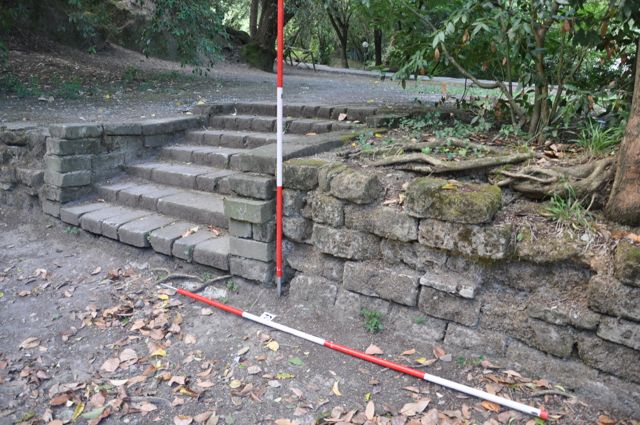
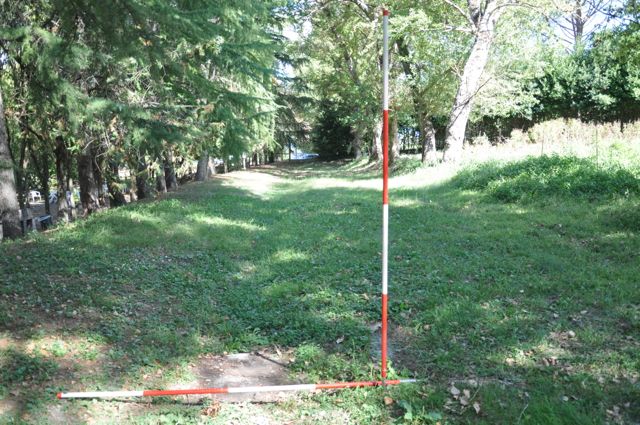
Steps down into the smaller of the two sunken areas south of the
visitor centre, the steps look modern, the walling? Not so sure, view
looking south west. Two terraces up, an old metalled roadway, view looking north.
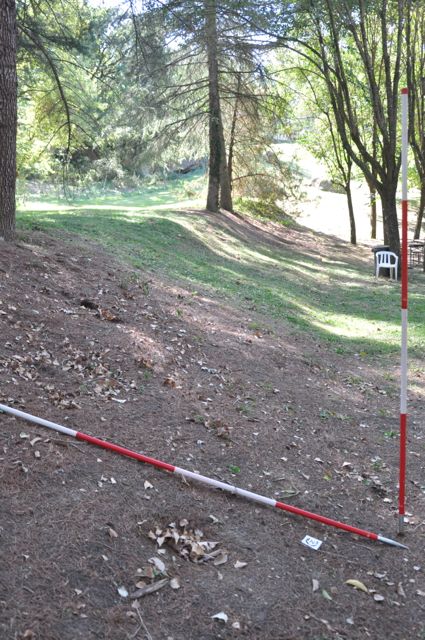
The bank between the trackway and the 'picnic' terrace, view looking south.
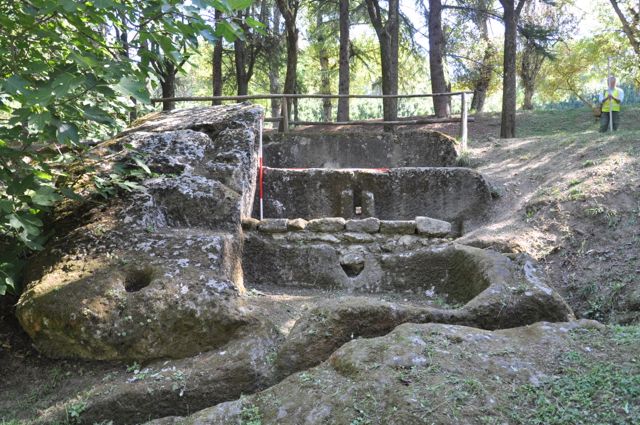
The complex of stone tanks, an ornamental fountain or a functional lavatoio (wash house)? View looking east.
I don't often quote Wikipedia
bit this seems apposite: 'Water was channelled from a river or
spring and fed into a building or outbuilding built specifically for
laundry purposes and often containing two basins - one for washing and
the other for rinsing - through which the water was constantly flowing,
as well as a stone lip inclined towards the water against which the
washers could beat the clothes. Such facilities were much more
comfortable than washing in a watercourse because the launderers could
work standing up instead of on their knees, and were protected from
inclement weather by walls (often) and a roof (with some exceptions)'.
|
After that I returned to the terraced area
next to the leaning tower and recorded the absence of flanking stairs
to the sometimes named ‘Theatre of Love’ and the
presence of three phases of walling. I was also quite taken by the
measures to ensure that although the tower was seriously tilted water
would not gather on the backward sloping bench. I also spent time
on the square vaguely medieval looking tower on a massive boulder on
the next level up. After a little scrambling I was able to peer inside
the tower in an inconclusive way, it would be very useful to see this
as a water tower (cf. Modave) but the evidence is less than conclusive.
Next it was on to the river god, neither Neptune or Pluto seemed
plausible to us and on the basis of similar figures at Caprarola we
were happy to ascribe him to the Tevere or River Tiber which the water
from the park flows into a few kilometres to the east. Next
up the possible site of a fountain in the form of a reproduced Meta
Sudans from Rome , a very heavily
rebuilt structure at best… more to do tomorrow but where would the
water have some from? One speculative point
that emerged during the day was regarding the uneven degree of wear on
and between different sculptures. Some are so heavily worn as to be
describable as 'smoothed by age', others remain sharp and crisp, could
there have been a measure of re-cutting?
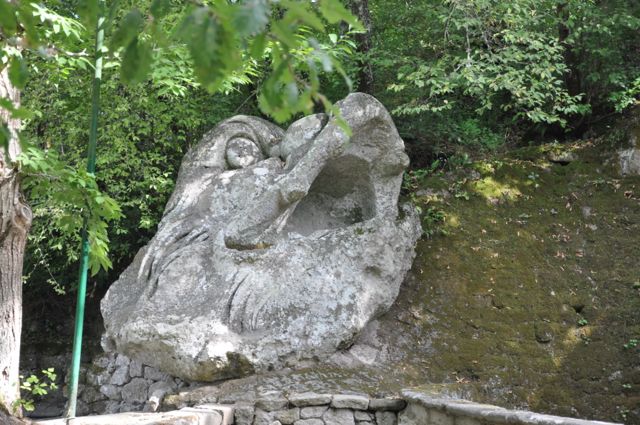
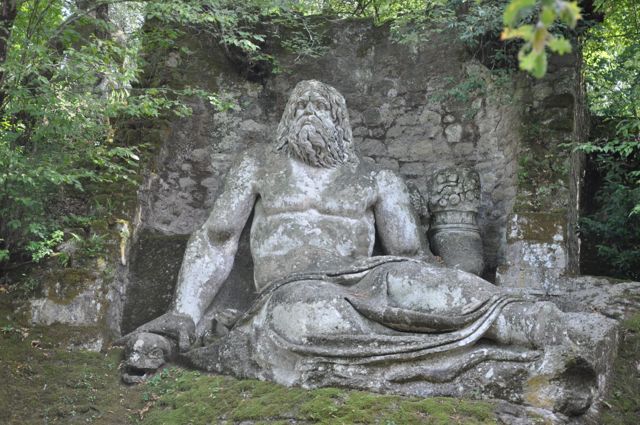
A fish head, large but quite jolly looking flanking 'Neptune' (sorry to
disagree here but as Michael said, 'Where's his trident?'), both views
looking south east.
As far as we could see the only source for the water in the pool below was the smaller fish head he has his hand on.
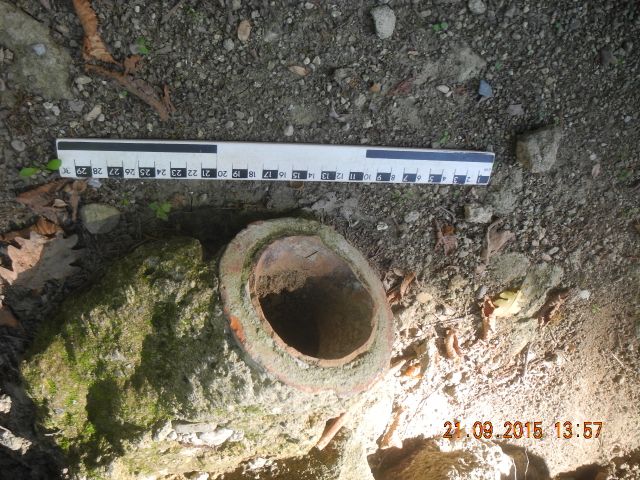
The pipe exiting from the outer pool below 'Neptune', presumably taking water down to the fountain in the centre of the Theatre.
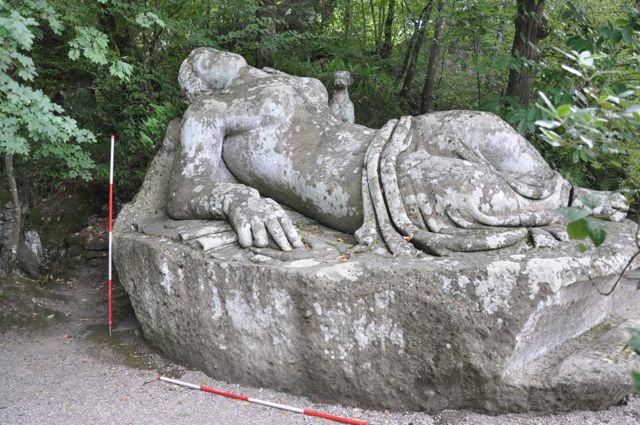
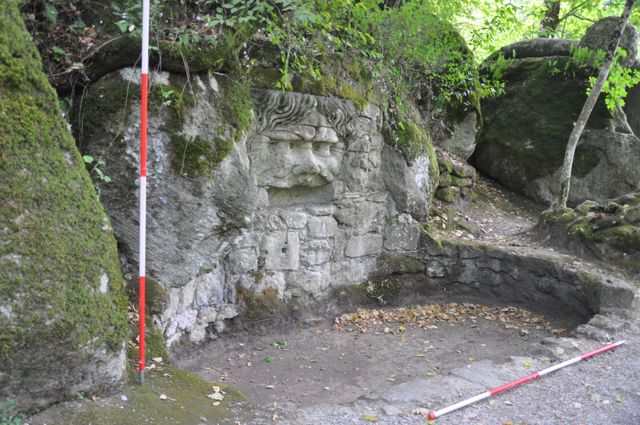
Just round another corner we have the Sleeping Woman BMZ15/46 (other
commentators have taken a less than charitable view of her), view
looking south and a small mask fountain BMZ15/47, view looking west.
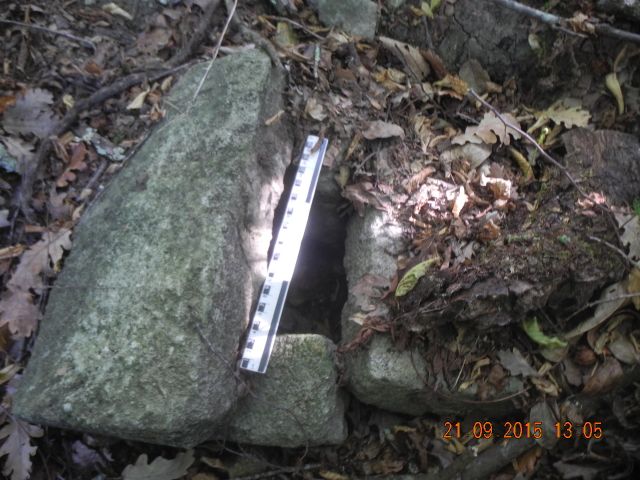
On the slope above the mask fountain evidence of a culvert BMZ15/47/c
to bring water down from the terrace above, this kind of evidence is
remarkably thin on the ground.
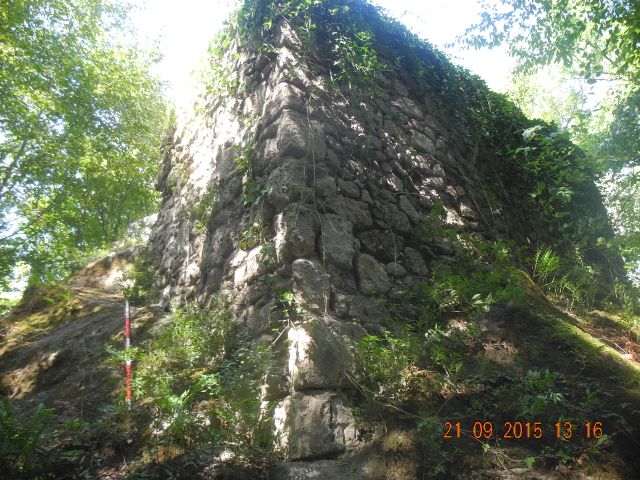
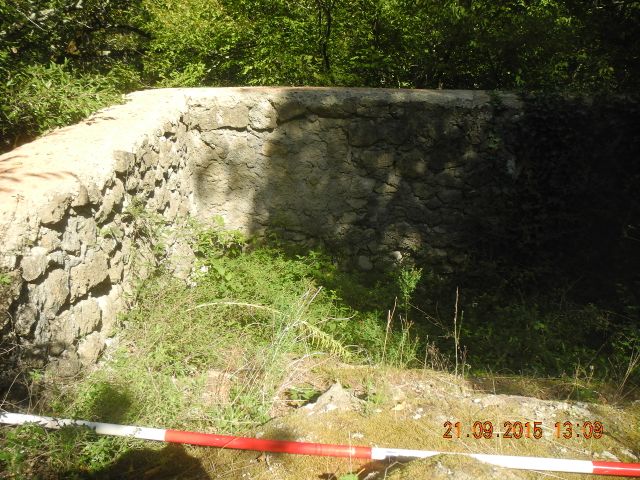
The enigmatic square tower BMZ15/49 perched on a boulder above a small
cavern, view of the south corner looking north and the interior looking
north east.
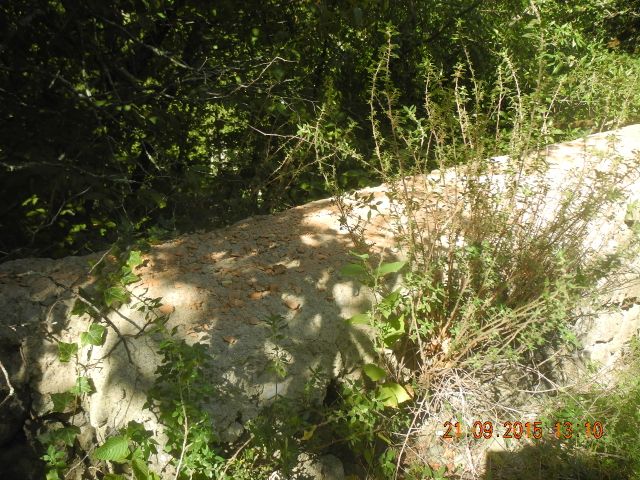
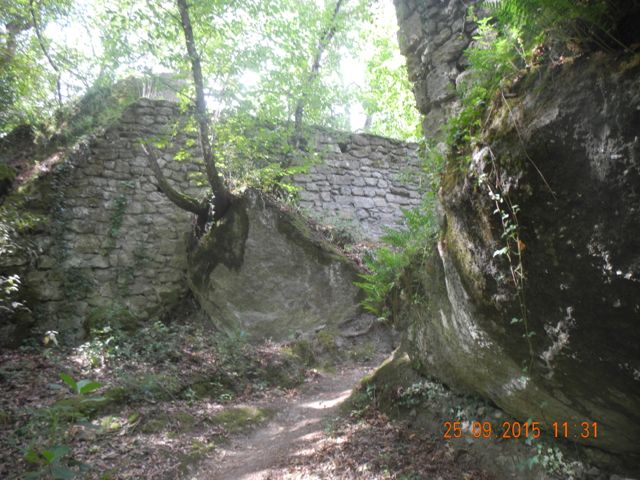
An interesting technique for capping the tower wall. View of the
terrace behind the tower looking west. Water for the tower would
have to have been brought across from here.
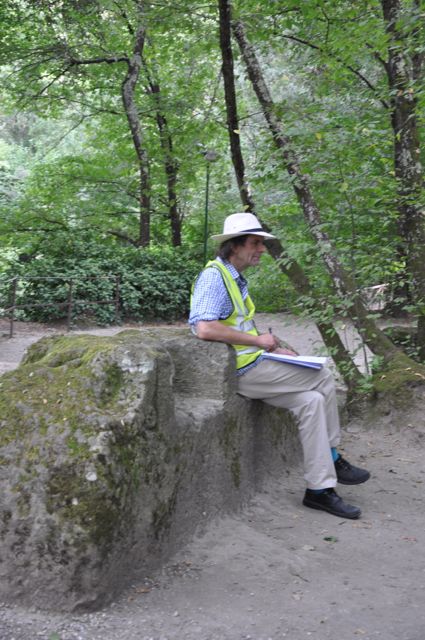
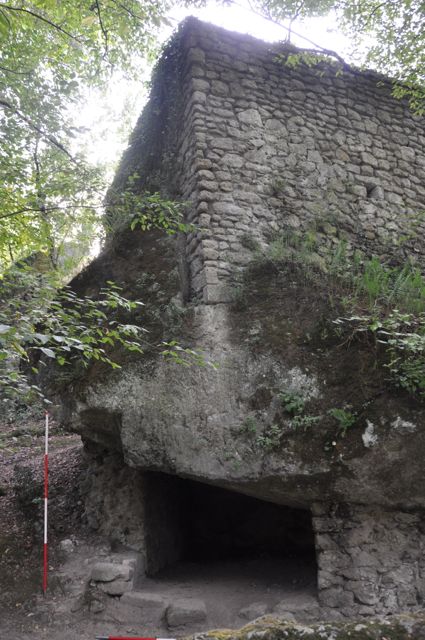
Lost in thought perched on one of the two seats BMZ15/48 facing this view: the tower and cavern BMZ15/51looking west.
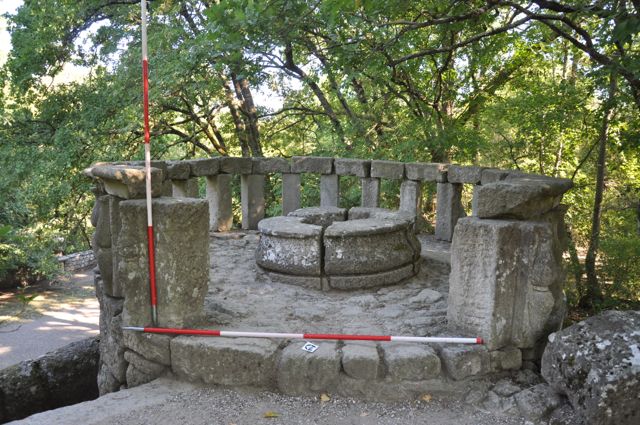
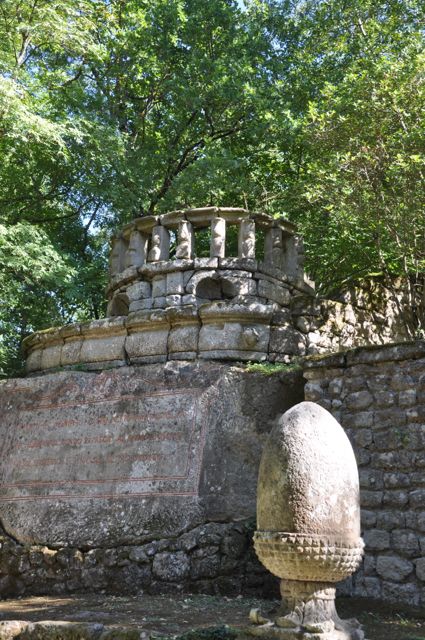

BMZ15/51 or the Rotunda or Meta Sudans (a famous fountain
from the good old days in Rome): view looking north, view looking south
and view looking down onto the lower level of the heavily rebuilt
structure.

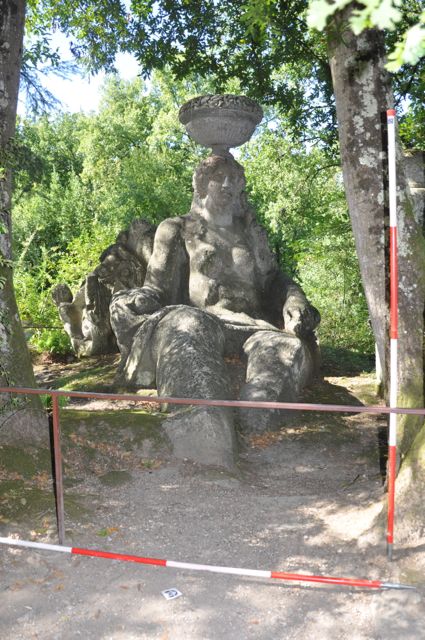

Ceres BMZ15/66: irregular shallow stone basin looking north, view of
eroded figure looking north west, fun and games on her back, more
upsidedownness, view looking south east.
In a letter dated 1578 Orsino
commented that his son who he called, one hopes fondly 'il figgliaccio'
or ugly son was already 'half a giant' and that together with Oranteo,
his daughter, they had managed to turn everything upside down! So
here's a radical idea could elements in the garden have been elaborate
tributes to his children?
|
As this was the last day before Lindsay’s departure for the UK in his
car with our equipment we tried hard to complete all the key
photographic and surveying tasks. We also committed to an early start
so the first couple of hours were blessed with cool temperatures and
few visitors. By now we were operating down at the far northern end of
the garden and Michael and Lindsay were introduced to further stone
tanks cut in the top of a distant boulder adjacent to a small stone
shed with basin. This was subject to careful recording whilst I worked
my way down towards the stream in search of the last major feature to
be visited, a large rectangular basin with possible fountain attached.
This had all been in quite ruinous condition but had recently been
restored, presumably with an eye to opening a further section of the
garden to the public. Most striking was the dam / wall / causeway which
closed the northern side of the tank and the upper course at least was
partly supported on corbels. A close parallel to the dam / wall /
causeway by the upper lake but not exact and the whole thing rather
compromised by a heavy degree of repair work. There were several
other features of interest in the area which I documented before
returning to the main part of the garden to finish drawing the
potential meta-sudans, Verna had been taking pictures all morning and
we finished off with the so-called faux Etruscan tomb façade, still not
sure about this, and some more worked boulders by the path back to the
visitor centre.
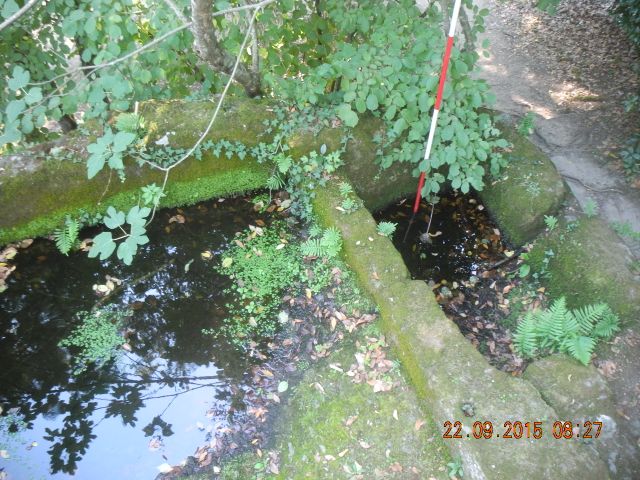
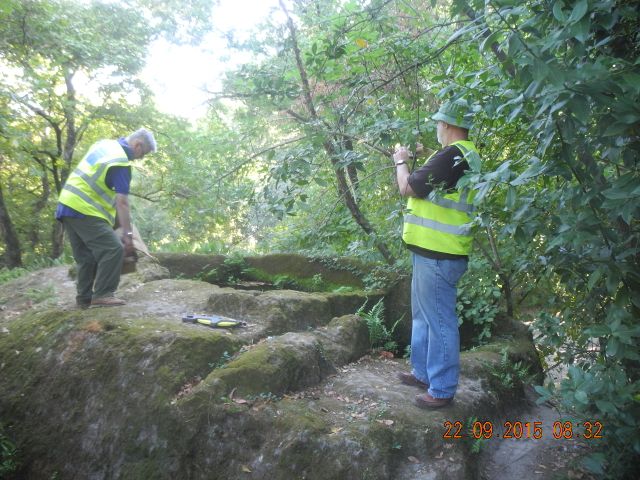
Another set of boulder top tanks BMZ15/56, these still partially water
filled, view looking south. Michael and Lindsay prepare to get to grips
with it all.
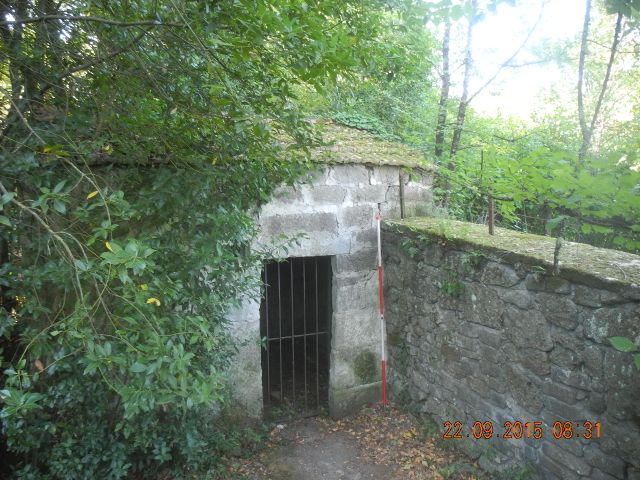

The small hut BMZ15/33 nearby, partially cut in the rock, view looking north west, and containing a basin, a bottle and a pole
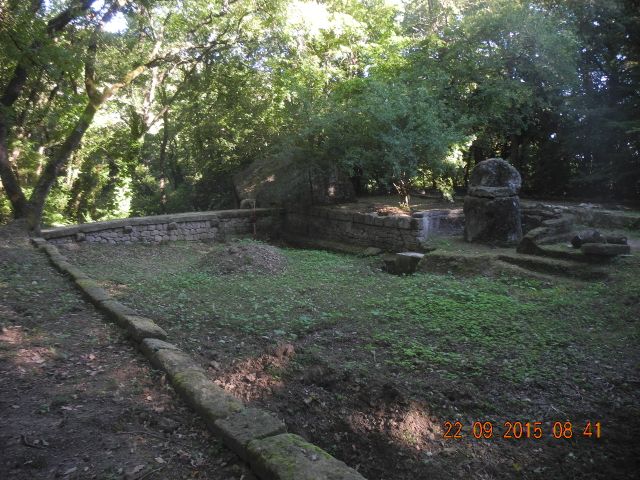

Down to the valley floor view of pool and possible fountain looking north, detail of the fountain looking south west.
THIS PART OF THE GARDEN IS NOT CURRENTLY OPEN TO THE PUBLIC
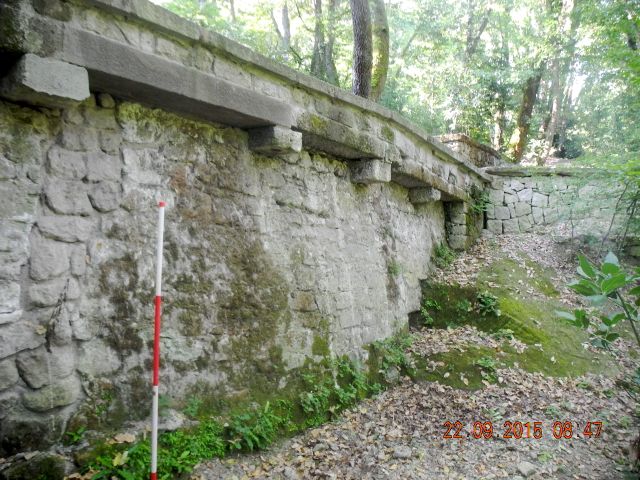
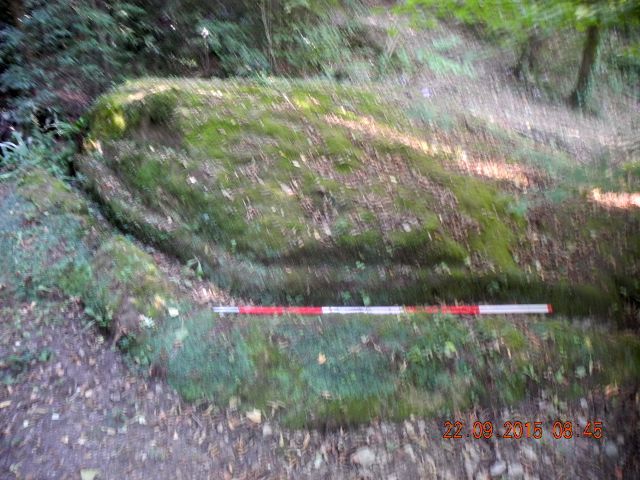
The dam and causeway BMZ15/57 at the north west end of the pool looking
south. Channels cut in rock to the south east of the pool
BMZ15/62, looking south.
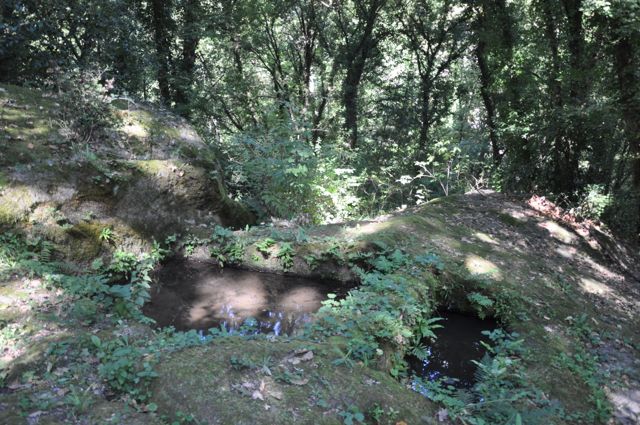
More rock cut water filled basins BMZ15/63 north of the dam looking north.
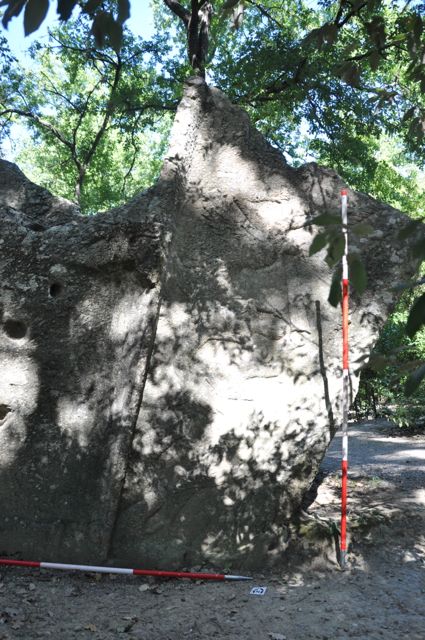
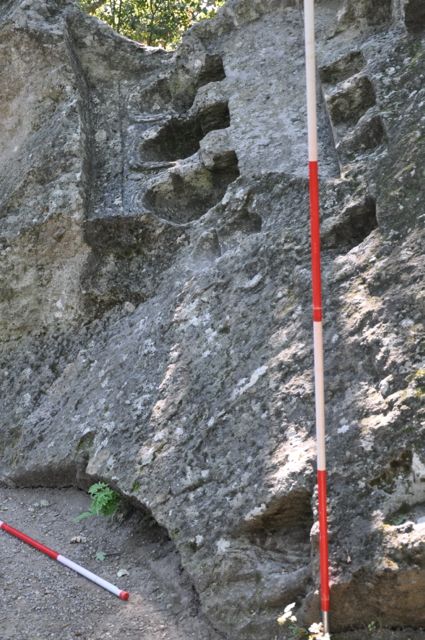
The Etruscan ruin BMZ15/54 , fake or real? View of pediment from south, view of columbaria from north.
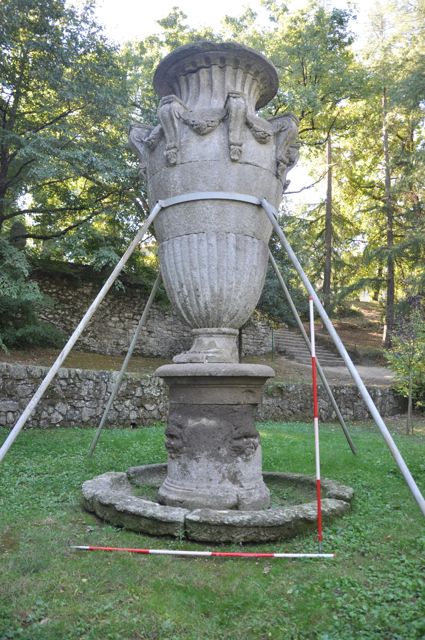
The Monumental Vase BMZ15/64, rather ungainly proportioned but it
stands in a small basin and looks as it it should have been watered,
view looking south.
After lunch the others made a start on recording further features up
the hill towards the palazzo whilst I hiked round by the lane to take a
look at the triumphal entry from the outside. This was a snatched
moment as we had made an arrangement to met with Signor Bettini, this
proved to be a very productive session. We were able to take a look at
some of the early publications in the display cabinets and then in
conversation with Verna, all in Italian of course, we were able to
discuss some key points including the fact that both entrance arches
had been relocated: the triumphal arch from the lower northern end of
the park where it framed the main entry that then lead up the ramp to
the terrace in front of the leaning house. The castellated archway had
been relocated from a position further to the east where it had
originally faced the other way and framed a view up to the palazzo. We
tried to establish information concerning the possible location of
formal garden terraces on the hillside below the palazzo
and to the
east of the stream. Signor Bettini agreed that the terraces were old
but told us that the potential pool areas dated back only 40 years. He
had
no explanation for their presence and I remained fairly convinced that
there was antique stone work to be seen here. Anyway it all ended
amicably with Lindsay handing over a first draft of his magnum opus and
us being offered beer and an invitation to return on Wednesday for a
technical talk with one of the gardeners and on Friday to meet the
conservation architect working on the restoration!
Wednesday September 23rd. Villa Lante, Bagnaia
We decided to head on to Bomarzo where Signor Bettini had invited us to
interview his head gardener, Fabrizio on the subject of water supply so
after lunch we sought him out. After extensive questioning we got no
further than an insistence that the stream was the only source of water
in the park and all the fountains were fed from that, the uppermost
feature, we have termed the meta-sudans was not a fountain but simply a
viewpoint. If this is the case the water has to be carried behind the
wall to the giants’ terrace and then distributed down to the lower
levels. We also discussed the possible existence of the upper lake.
Fabrizio confirmed its existence in a slightly equivocal way and went
on to say that originally there was water in the rectangular basin in
front of the Mask of Proteous. He also seemed to confirm Signor Bettini’s
point that the two potential rectangular pools were modern additions to
the scene and that some of the smaller rectangular stone basins were
washing places.
Next on our list of things to do was to make the ascent to the old town
and palazzo. We spent some time examining a bastion like feature on the
hillside immediately below the town. It had been suggested that this
had been a large water tank but the structure had been so heavily
restored that it was no longer clear exactly what was going on. We also
took a look at the rather sad remnants of a modern fountain which
apparently had cost many thousands of euros and had run for a couple of
years but was now derelict. It was a bit of climb up the old town but
views down to the park were impressive as were the views up to the
Palazzo Orsini. Unfortunately it was only open at the weekend so we
meandered around the impossibly picturesque medieval town before returning to the car.
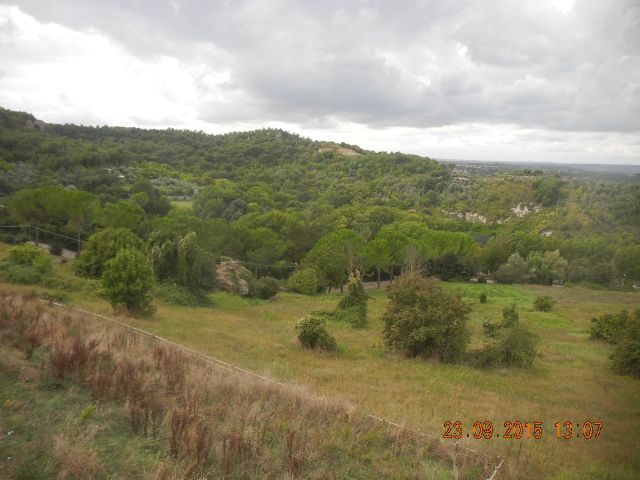
View from the town looking west across the park.
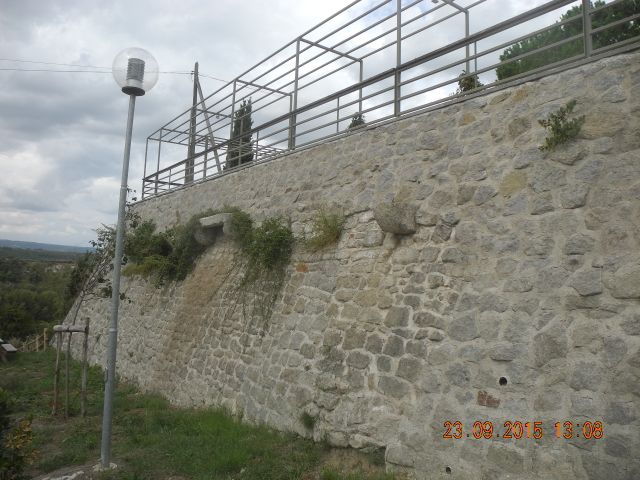
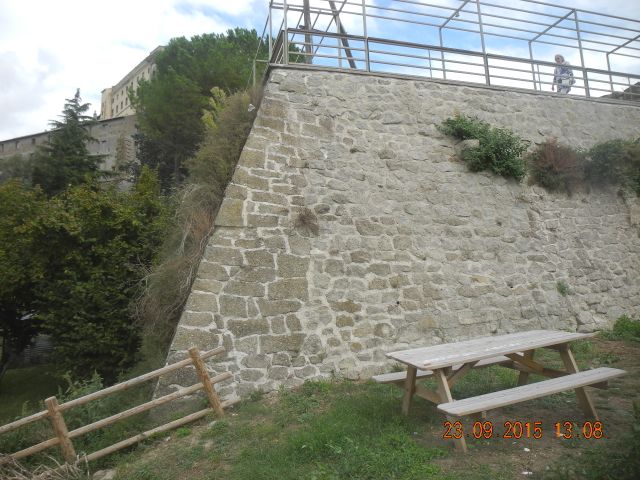
This bastion like feature BMZ15/81 has recently been remodeled to form
a car park, Lindsay believed that it was formerly a large water storage
tank.
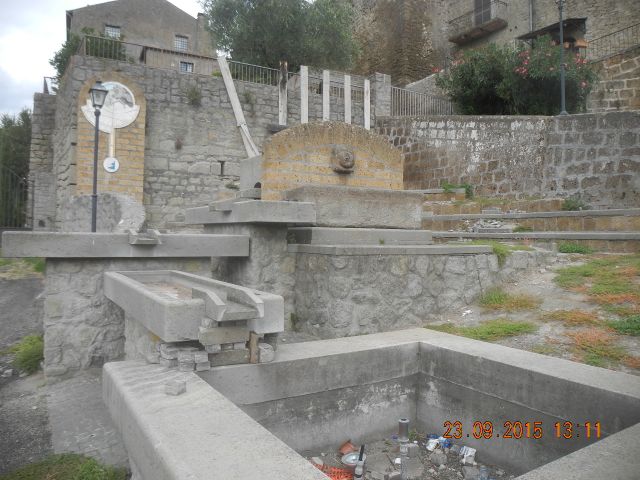
Up the road a little the sad remains of a modern but now neglected fountain.
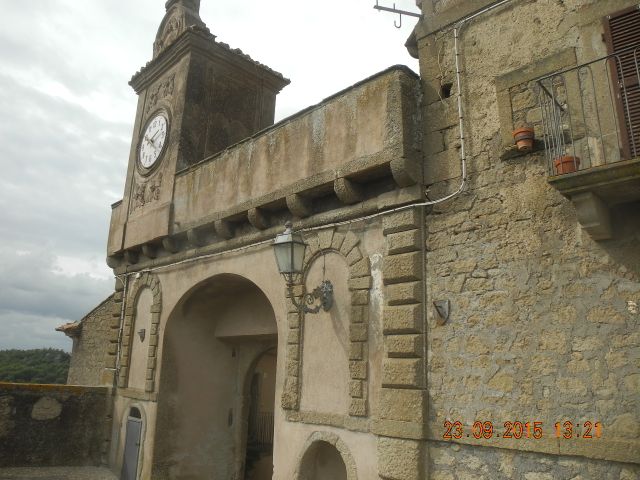

The south eastern gateway to the town of Bomarzo and buildings in the square opposite the
Duomo.

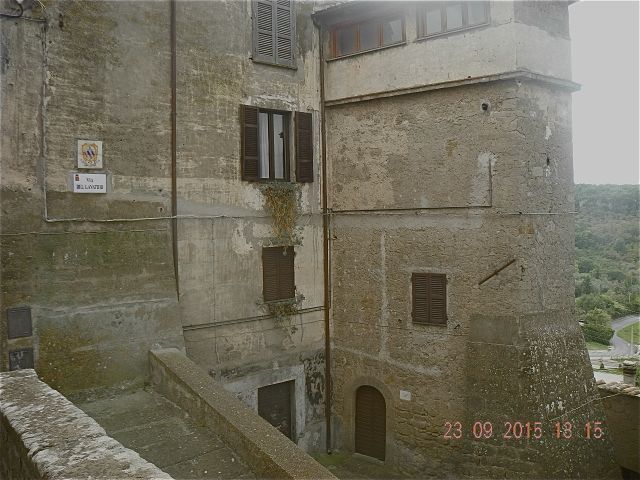
Another Orsini bear adjacent to the
Duomo
steps.
The
Via del Lavatoio (Laundry Road) leading down towards the park.
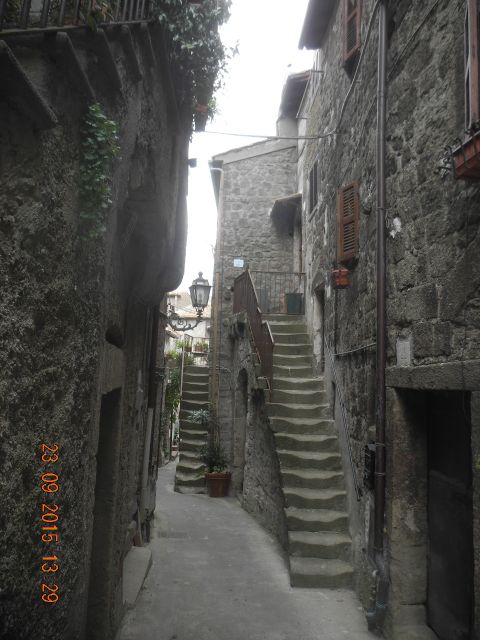
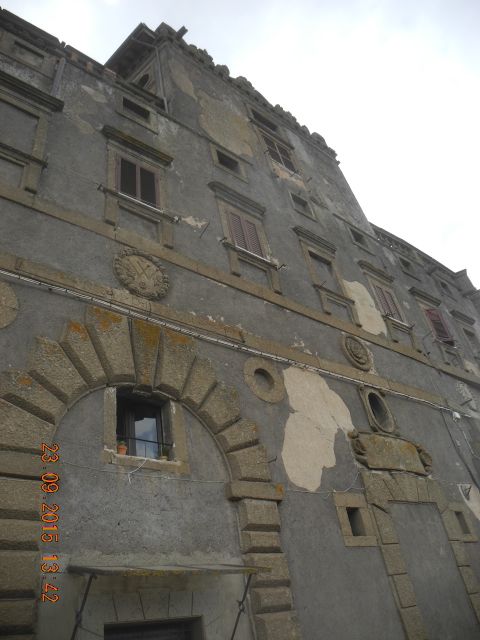
Picturesque medieval steps and street and the facade of part of the
palazzo.
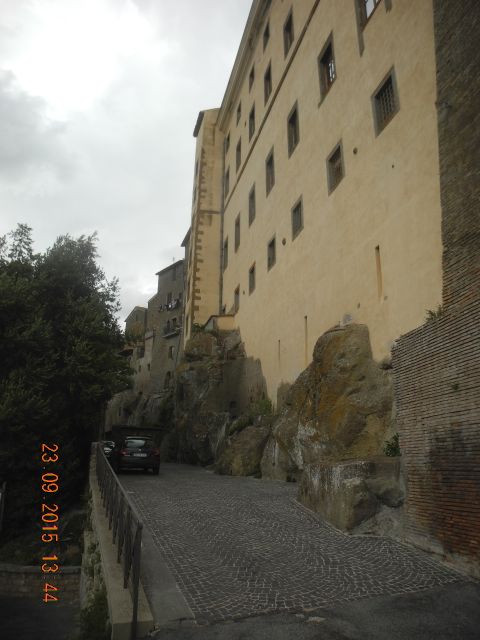
The west face of the
Palazzo overlooking the park.
Thursday September24th.
A day off so we decided to head up the road to the north for the hill
top town of Orvietto. Just half an hour away we parked in a huge modern
car park and walked up a series of sloping walkways and staircases (the
escalators had been turned of) into the heart of the town and quite
spectacular it was too. After a quick coffee we began with a visit to
the cathedral, generally recognised as one of Italy’s finest medieval
buildings, strikingly banded in white and green marble the west front
is a tour de force of decorative surfaces and mosaics. The interior is
comparatively austere but the transept chapel frescoes are astonishing,
particularly the north transept with work by Signorelli, which
features some wonderful grotesques in the scroll work which make
Bomarzo’s sculptures appear rather tame. I then lead everyone on a
lengthy walk to the end of town to visit the rocca, great views, the
Etruscan temple, closed, and the Well of St. Patrick, full of
visitors, so we headed back to the cathedral and did its associated
museums, some archaeological some art historical with a number of
standout pieces including a library with marvelous painted walls, a
brilliantly light footed St. Michael perched on the back of a dragon
and a troop of angels folding back a set of bronze curtains to reveal
the seated Virgin within.
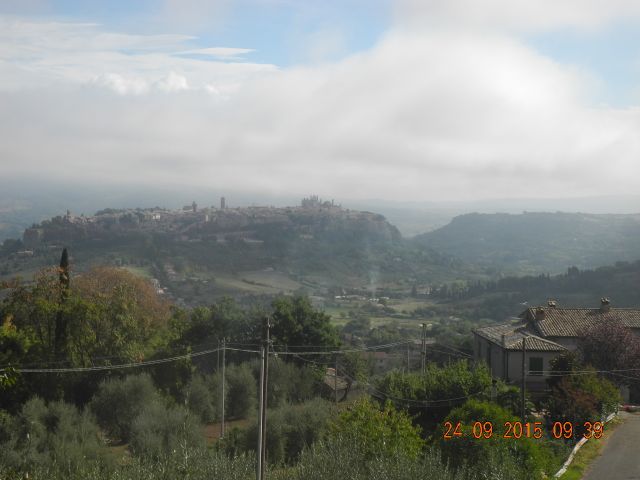
Orvietto viewed from the south west.
Friday September 25th.
In keeping with the arrangement we had made with Signor Bettini earlier
in the week we returned to Bomarzo for 11.00 to meet with the architect
Maria Louisa Del Guidice who for the last eight years has been
supporting the restoration work in the park. We began our discussions
in the café where over maps and with scribbled annotations she confirmed
many of the hypotheses we had been developing. It was clear that much
remained to be discovered concerning the details of the water supply
but the outlines were clear. The water is derived from the stream and a
conduit taken from the shallow rectangular basin in front
on the Proteous mask must have run broadly along the line of the
current path down towards the river god fountain. From this line
inter-locking terracotta pipes took water off to the other fountains on
the lower levels and then discharged water into the stream. Unfortunately she had no
knowledge of any automata associated with the park and her main conclusion
about Orsino was that he was a bluff soldier with influential friends
and interesting ideas but without the financial clout to mimic the
gardens at Bagnaia or Caprarola. We raised the issue of the worked
stones scattered round the park and she indicated that the features cut
into them could be of any age from Etruscan to the last century and
that they were a combination of house platforms, animal troughs and
washing places with the occasional tomb thrown in for good measure.
To our pleasant surprise she then offered to take us round for further
discussions on the ground. She was quite clear that the landscaping
south of the visitor centre was all about providing recreational areas
for early groups of visitors and that the land below the palazzo was
given over to productive practices such as the cultivation of fruit
trees. She was less sure how the water had been taken from the upper
cascade nor were we able to establish exactly how the main dam with its
curious loop hole actually functioned. Down at the fountain of Pegasus
she was of the opinion that the basin had slipped following the
construction of the feature and that there was nothing particularly
symbolic about it. We did discuss the possibility that the water level
in the stream was higher at certain points through the agency of a
series of lesser cascades. The effect of one of these could have been
to raise the water level adjacent to the Orca so as to give the effect
of the mouth rising out of the water.
She was not terribly convinced by the idea that jets of water
squirted up around the seats of the nymphaeum but was not able to say
for sure. She was able to point out a line of terracotta pipes taking
water away from the standing figure next to the theatre and down across
in front of the leaning house. She had no particular suggestions
regarding our idea that the tower had in fact been a water tower but
certainly didn’t dismiss it out of hand. We were then granted access to
the lower zone where the current work was being undertaken on what she
called the piscine.
Her idea was that the stream had been diverted to
fill the pool with water which then flowed out at the far end. In
discussing the relocation of the entrance arch she made it clear that
in her opinion the original approach to the garden was from the north
bringing visitors in past the lower pool and fountain and up the ramp
on to the terrace by the leaning house.
Finally
back up to the river god fountain where we compared notes on the stub
of pipe emerging from the outer part of the basin. She confirmed that
some of the sharper edged sculptures had been restored in the last
century and shared with us the intriguing idea that the elephant
sculpture was to commemorate the death of Orsino's son at the battle of
Lepanto in 1571. That was about it so after a final round of thanks and
farewells we returned to base camp and the expedition was all but over.
All that remained was a huge amount of plan, section and elevation
drawing to process back home and a lot of thinking to be done.
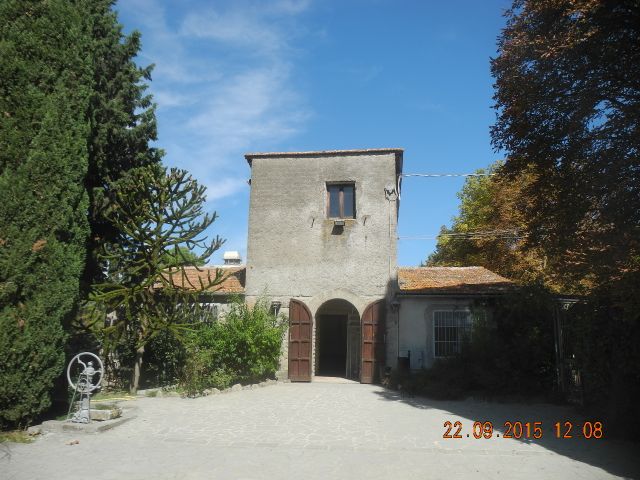
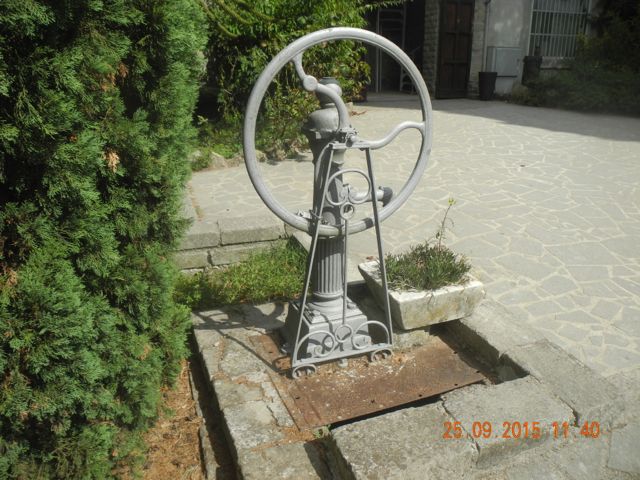
The south end of the visitor centre incorporates an earlier farmhouse
with tower, could a park keeper have lived here and kept his eye on
things? Detail of the hand pump to the right is a small marble bowl.
I like this:
"Bomarzo is a torment to the exegetes... There have been comparisons
with oriental art. Its execution has been called raw and dilettantish,
but also a work of refined sculpture. It has been read as the perilous
wood of the chivalric romances; a place of the triumphal entry of
sovereigns, a biography in images of Vicino's military career; a
pilgrimage through the pagan sacred mountain. It has been explained as
a Neoplatonic sanctuary, a creation of Epicurean philosophy, the
itinerary of the soul from human to divine love and a hieroglyph of the
alchemical work.'
Joscelyn Godwin in The Pagan Dream of the Renaissance, Boston: Weiser Books 2005 page 171.
One could also add it has been put forward as a visual interpretation of texts as varied as Ovid's Metamorphosis, Colonna's Hypneromachia Poliphili and Ariosto's Orlando Furioso.
How many of these commentators took to heart Orsini's own inscribed
words which describe the garden as being, 'only like itself and
nothing else'?
|
Our focus was unrelentingly on the ways in which water had been
used in the park and all our recorded features and most of the
photographs were concerned with gathering data for that investigation,
however, it would be foolish to ignore the other remarkable features in
the garden even if they have no discernible contact with water, so with
that in mind here are a selection of other images from the Park of the
Monsters.
The Proserpine bench looking south west and pine cones and acorns lining the hippodrome, view looking east.
The Mermaid Echina, two lions and a harpy all grouped at the eastern end of the hippodrome and viewed from the west.
In the hippodrome an Orsino heraldic bear with traces of the original paintwork remaining, looking north.
More rock cut anomalies: two pairs of broad parallel grooves about the
Ogre, looking north
east.
Steps and rock cut house platform east of the former lake, looking
north east.
